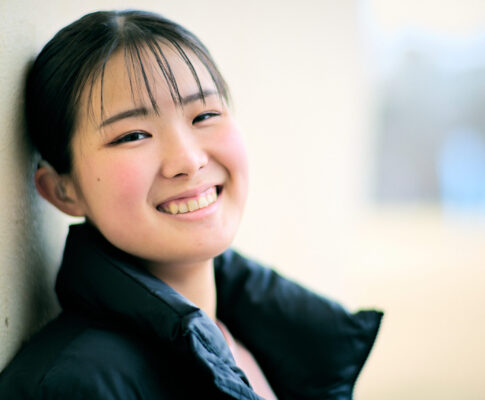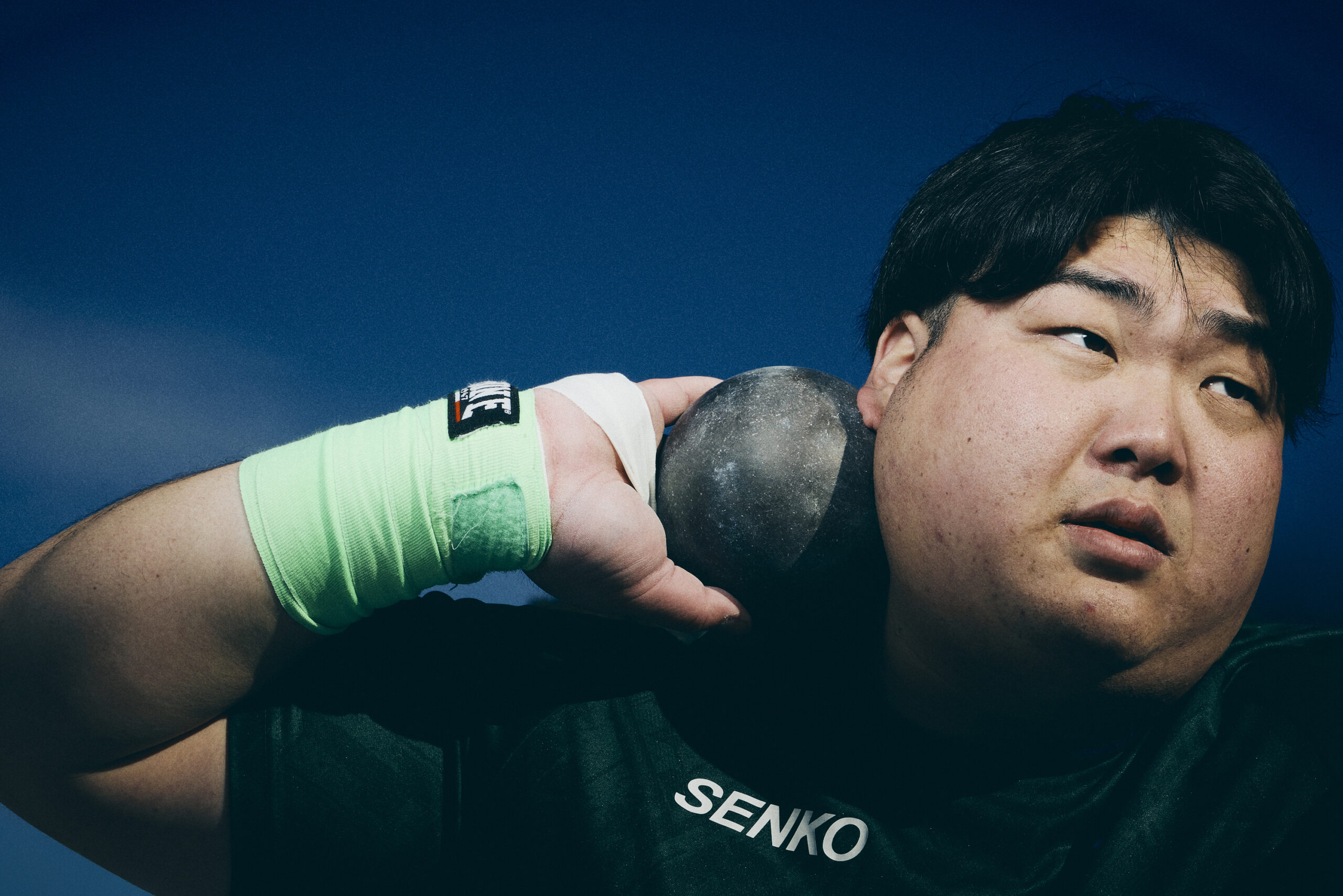
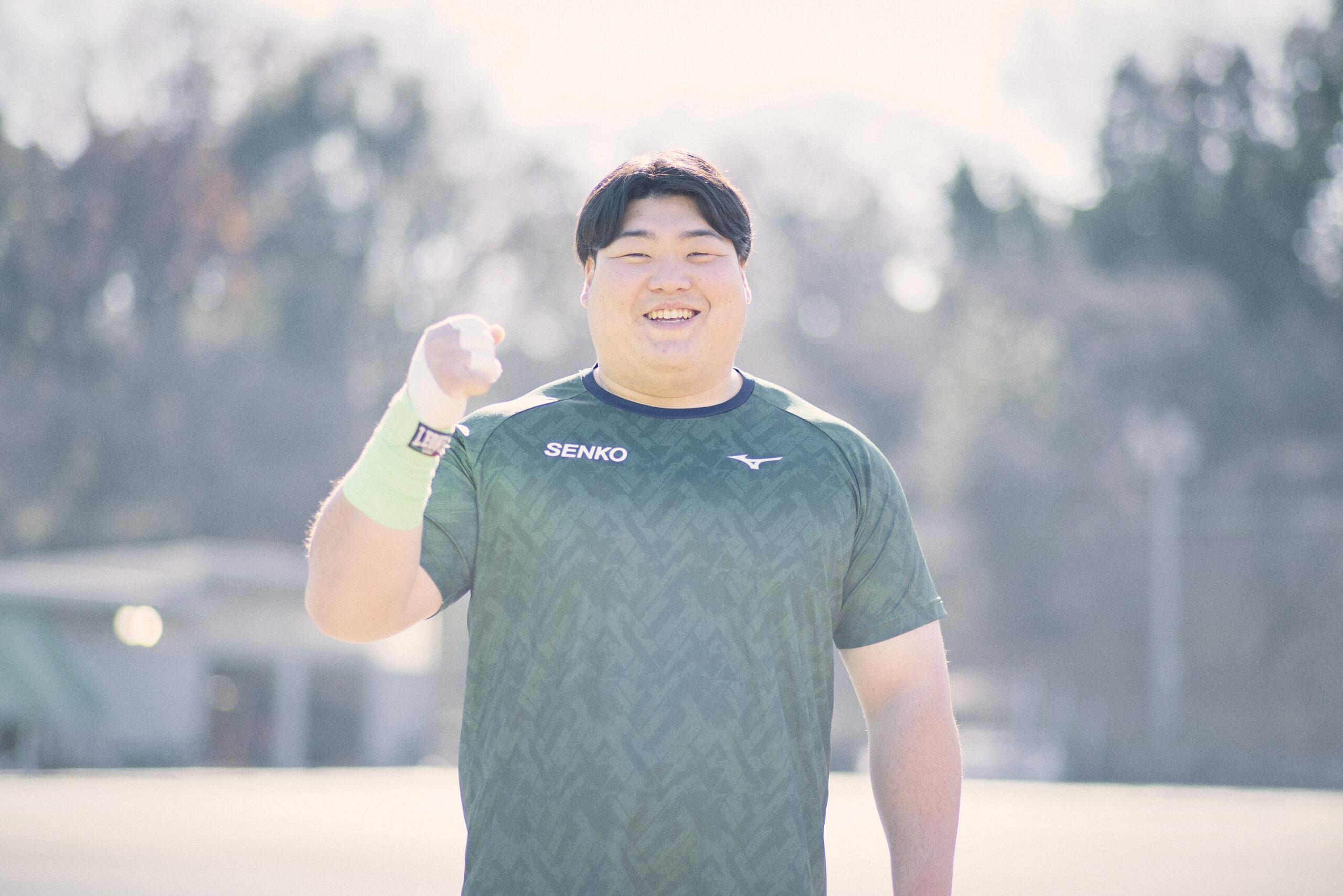
Hitoshi Okumura
Born in Fukui prefecture in 2000. Men’s shot put Japanese record holder (19.09m)
Graduated from Tsuruga High School and Kokushikan University. He has joined SENKO Co., Ltd. in April 2023.
In addition to setting a junior high school record (17.85m/5kg) in his third year of junior high school, he also won the National Junior High School Athletic Festival with a new tournament record. At Tsuruga High School, he also participated in the Inter-High School Championships in the discus throw. After entering Kokushikan University, his potential blossomed, and he won the Japan Inter-College Meet (All Japan University Track & Field Challenge Meeting) in his fourth year.
In 2023, the year after he became a member of society, he won the Japan Championships for the first time and finally became the top in Japan. In 2024, in addition to winning the Japan Championships for the second consecutive time, he won the All-Japan Business Team Championship and the National Sports Tournament to achieve the “National Triple Crown”. In August of the same year, he hit an unprecedented 19-meter mark and became the strongest athlete in Japan in both name and reality. In 2025, he will challenge the world with the aim of achieving even greater heights.
Pushing rather than throwing
――How did you get started in track and field?
I didn’t start until I was in junior high school. The local junior high school had a very small number of students, and there was only a track and field club and a kendo club. A good friend of mine joined the track and field club, so I joined the club with my friend. At that time, I had a height of 179 cm and weighed 85 kg, which was bigger than most people, so my advisor recommended me to try the shot put.
――When you were in junior high school, you also participated in national sumo tournaments, and when you graduated, you received an offer from the sumo wrestling room, but did you have any doubts about whether to try the shot put or sumo wrestling?
The advisor of the track and field club was not a shot put specialist. Even so, I was able to throw 12.84 m when I was in the second grade of junior high school. I was able to do sumo wrestling to some extent, but I wanted to work hard on the shot put, so I didn’t have any particular hesitation.
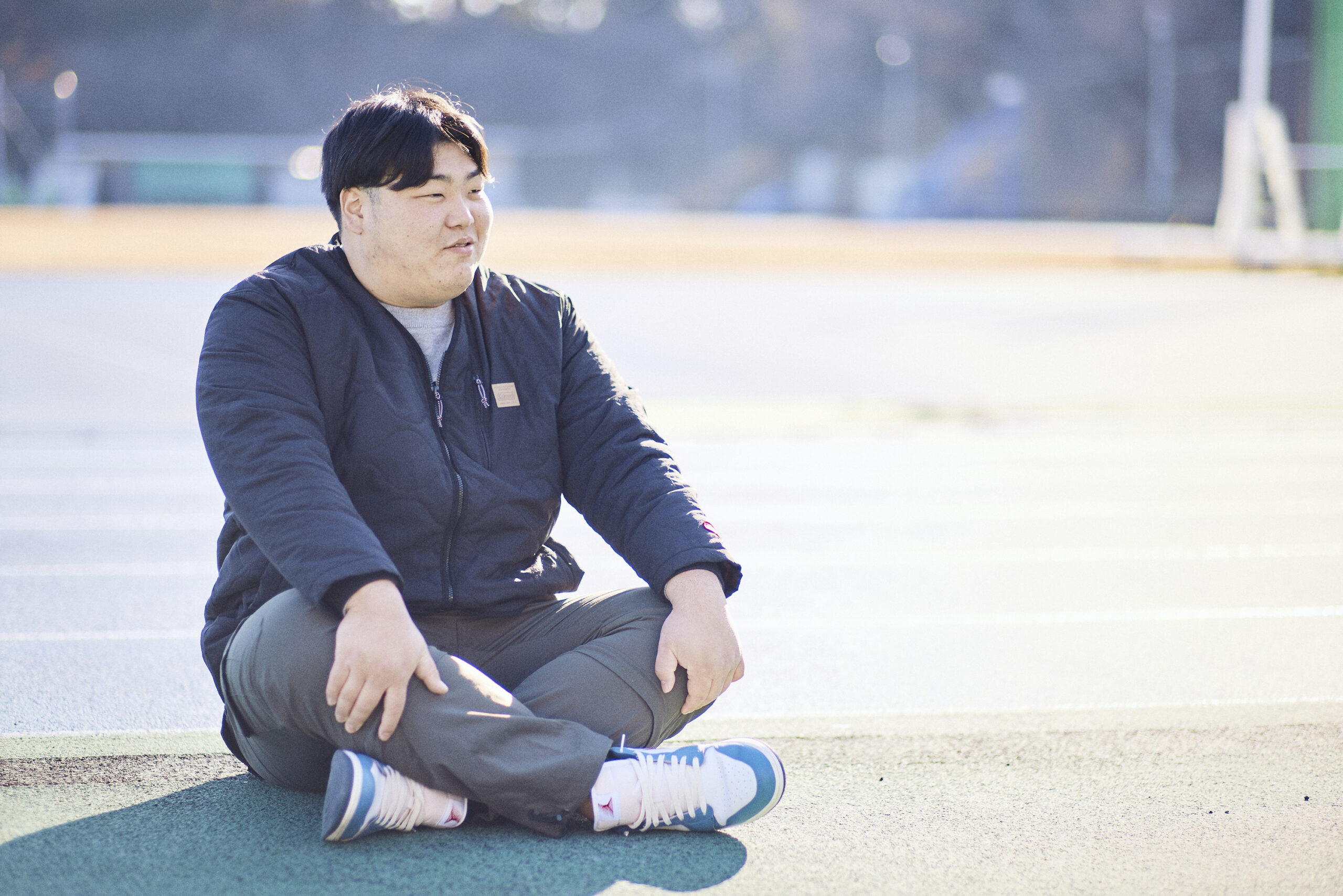
as he was twice as big as anyone else ever since he was a child
――What attracted you to the shot put?
I think the hammer throw and the discus throw are also heavy, but unlike other events, the shot put does not use centrifugal force because you put the shot put on your neck. It looks like you’re throwing things that are close to your body with force, but in fact, you can’t throw far unless you use various parts of your body. The more I did it, the more I realized that it’s not just about power. That kind of technical aspect is attractive, but also difficult.
――What do you need other than power to throw it far?
I think it’s understandable that you feel centrifugal force when you turn your body or swing your hand, but the way you transmit the force is important in order to throw an object far that is close to your body. Using the principle of leverage, centrifugal force is converted into propulsion. In Japanese, it’s called “Cannonball throwing”, but in English, it’s called “Shot Put”. It’s more like pushing than throwing. At the timing of the push, it is important to know how much force gained near the neck can be transmitted to the cannonball.
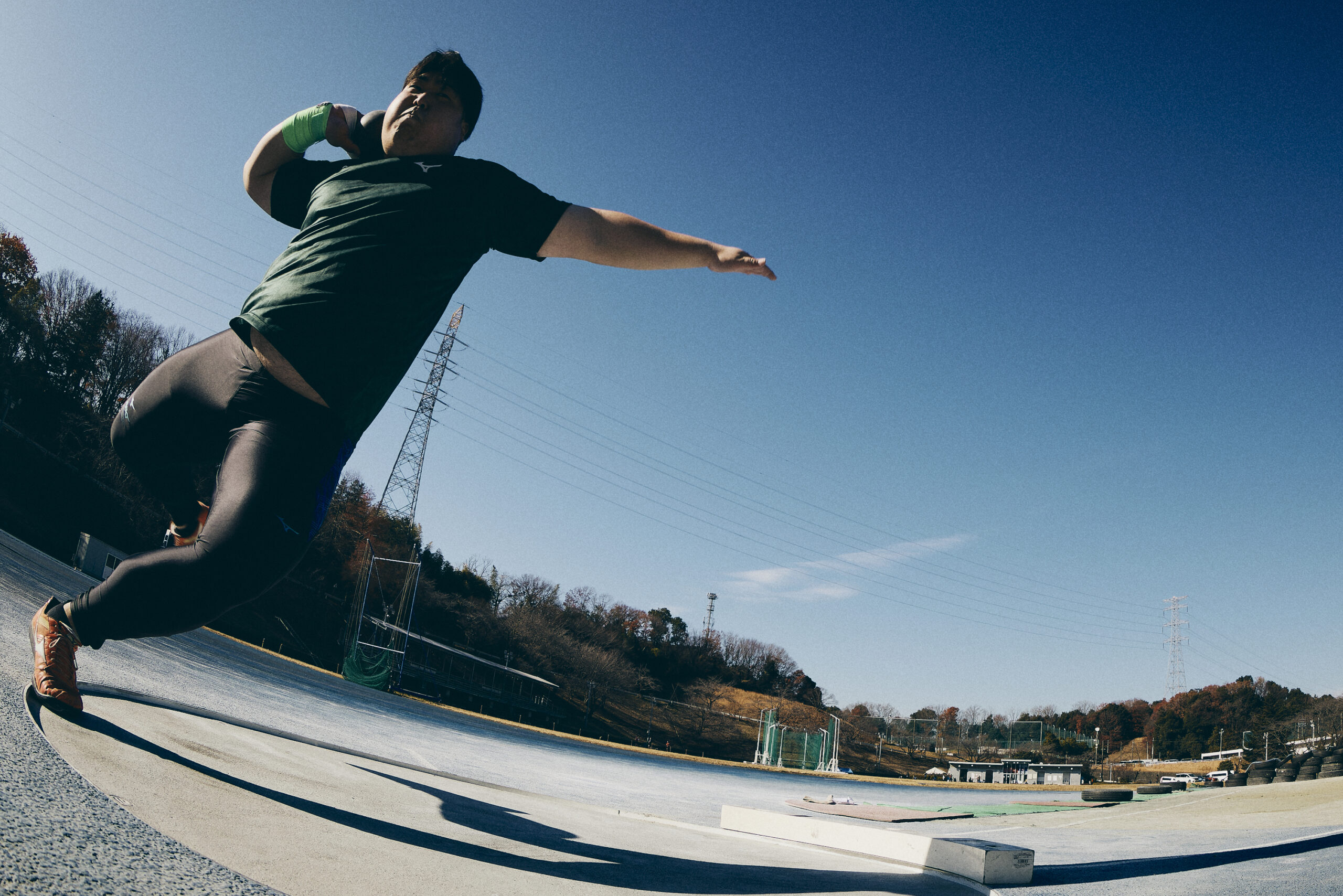
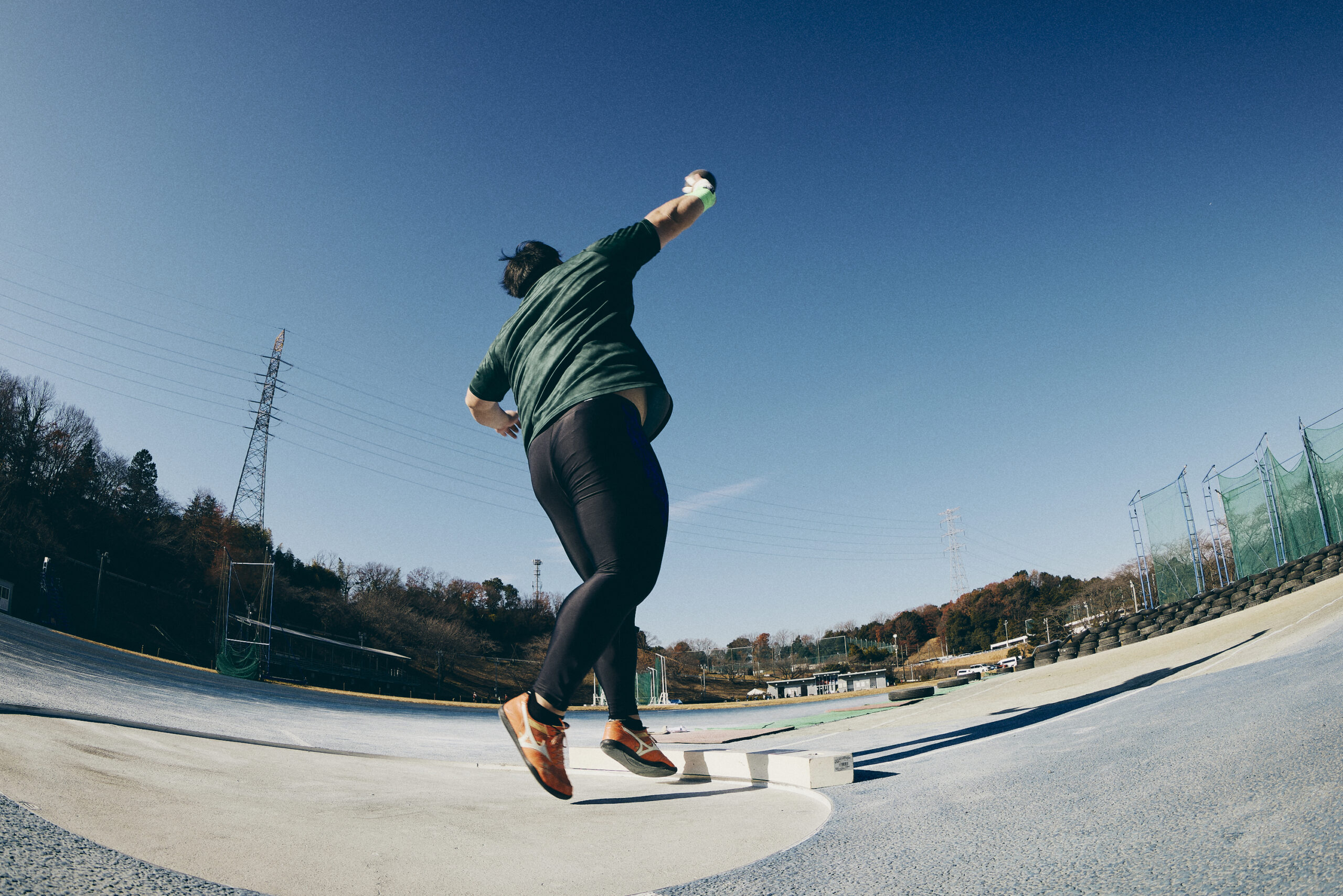
Self-awareness and independence: The pursuit of “form” leads to self-confidence
――Was there an event that was a turning point in your athletic career?
My first year as a member of society may have been a turning point in the sense that my way of thinking changed. I won the Japan Championships for the first time that year (2023) and went from the position of chasing to the position of being chased. At that time, I thought that if I continued like this, I might lose at the Japan Championships next year, and so I had to change something. When I was in college, I was honestly doing what I was taught. From there, I was able to think for myself, break it down, and put into practice after winning my first championship in Japan. I really feel like I’ve changed all at once.
――If you had to name one match where you made a throw close to your ideal, which one would it be?
It was last year’s (2024) Japan Championships. It was a better throw than the Fukui match in August (Athlete Night Games in FUKUI 2024), which set a Japanese record. Fukui was my hometown, so the atmosphere of the match was different from usual. But at the Japan Championships, despite the rain, I was able to throw 18.53m. In that sense, I think it was the closest to my ideal throw. If it hadn’t been for the rain, I might have been able to set a Japanese record.
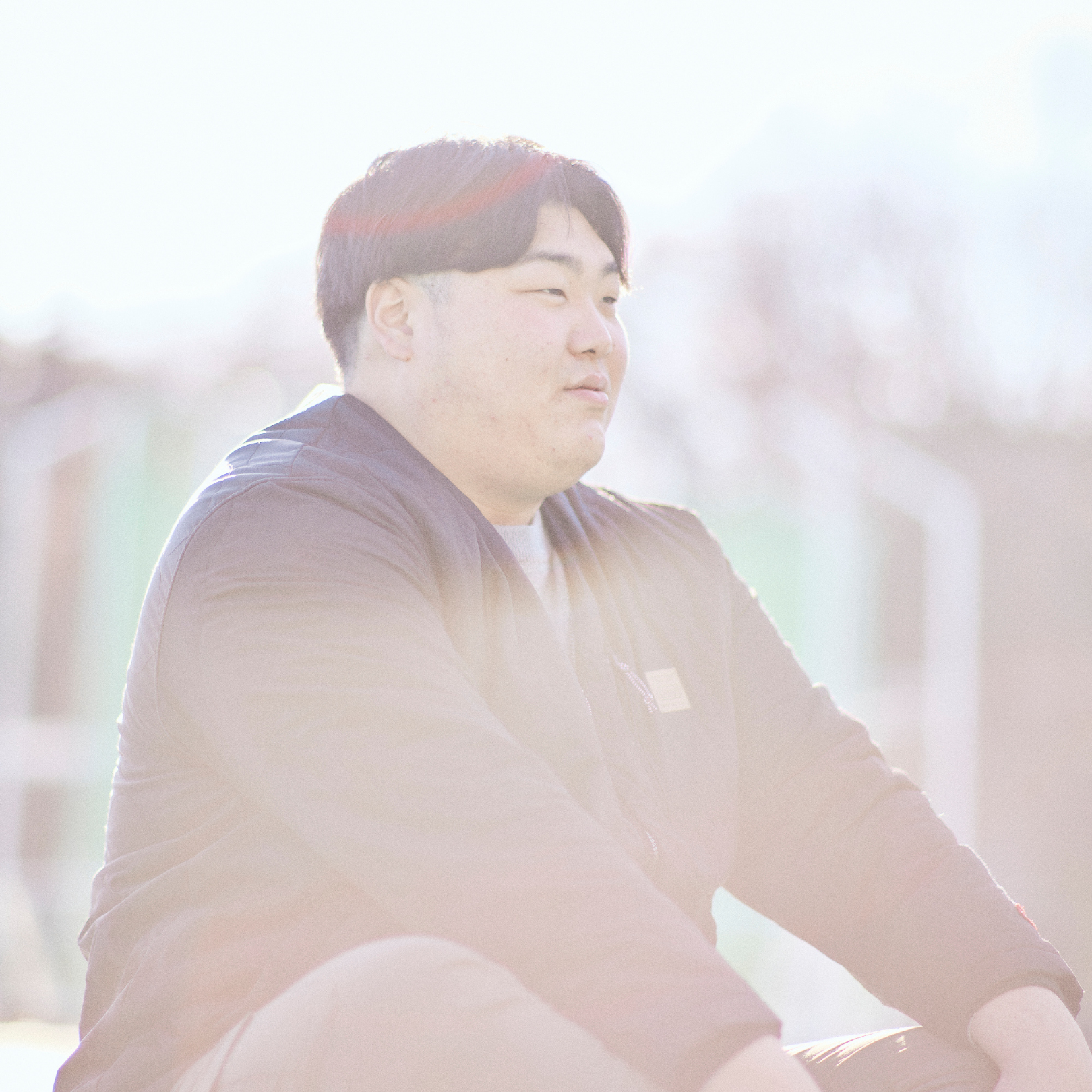
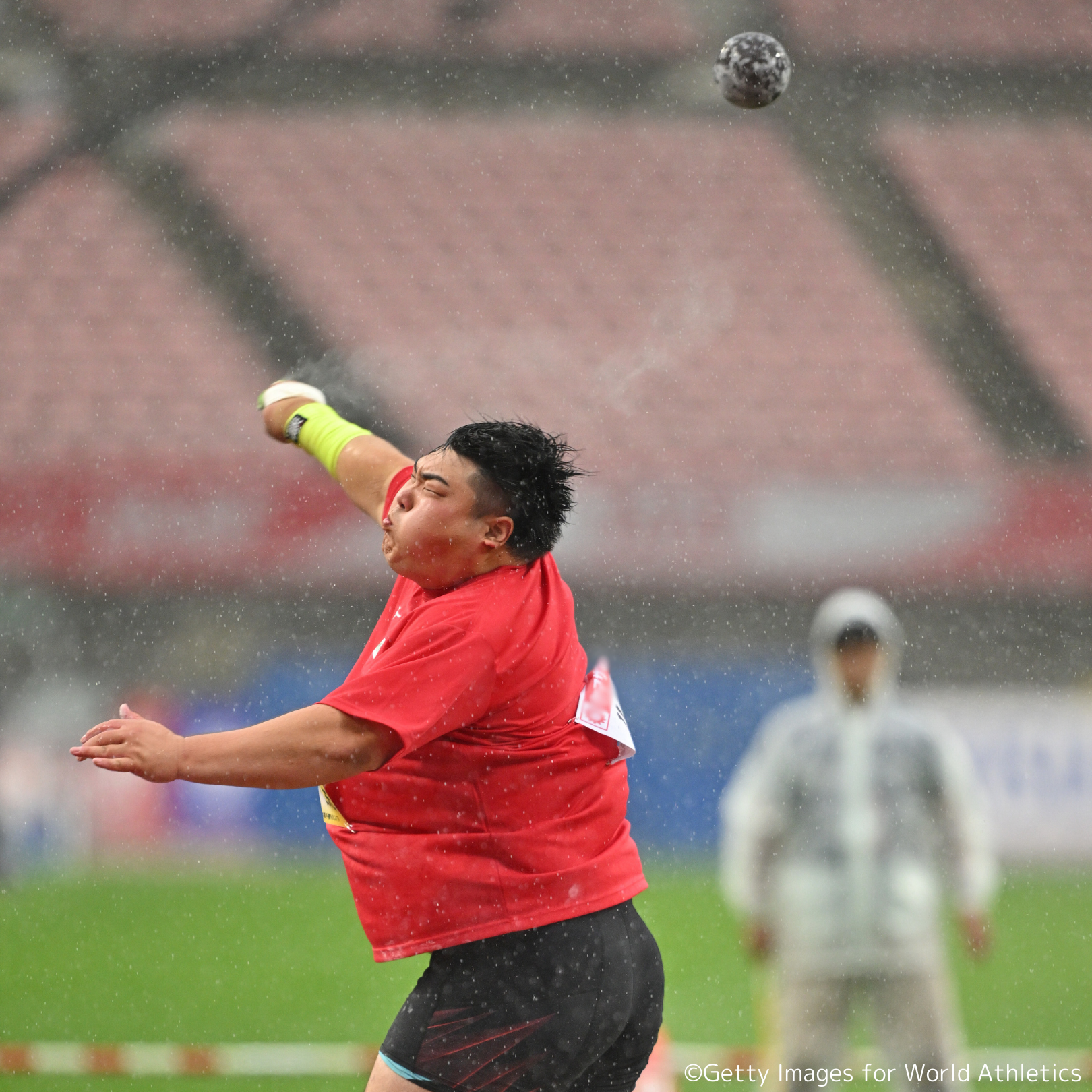
Having reached a turning point, he has seen growth through self-awareness and independence.
――What do you think was good about the Japan Championships?
In the case of rain, we usually take measures against the rain, such as slowing down the turns. However, I was able to increase my speed and throw as I practiced without feeling the rain. With this match, I had absolute confidence that I could win. However, I was able to approach it without hesitation, and I think it was mentally good that I was able to throw without fear of rain.
――Did you have absolute confidence in the fact that you had been practicing well before the tournament?
In my daily practice, I focus on “form” rather than distance. At that time, I had been conditioning myself for about two weeks, and I had formed the “shape” that I wanted. That belief had led to confidence. I’m the type of person who can improve my record by about 2 meters from practice in a match, so I basically don’t care about the distance during practice. If I can create the ideal “shape” in practice, and if I am satisfied with the approach, I will naturally be able to go into it with confidence.
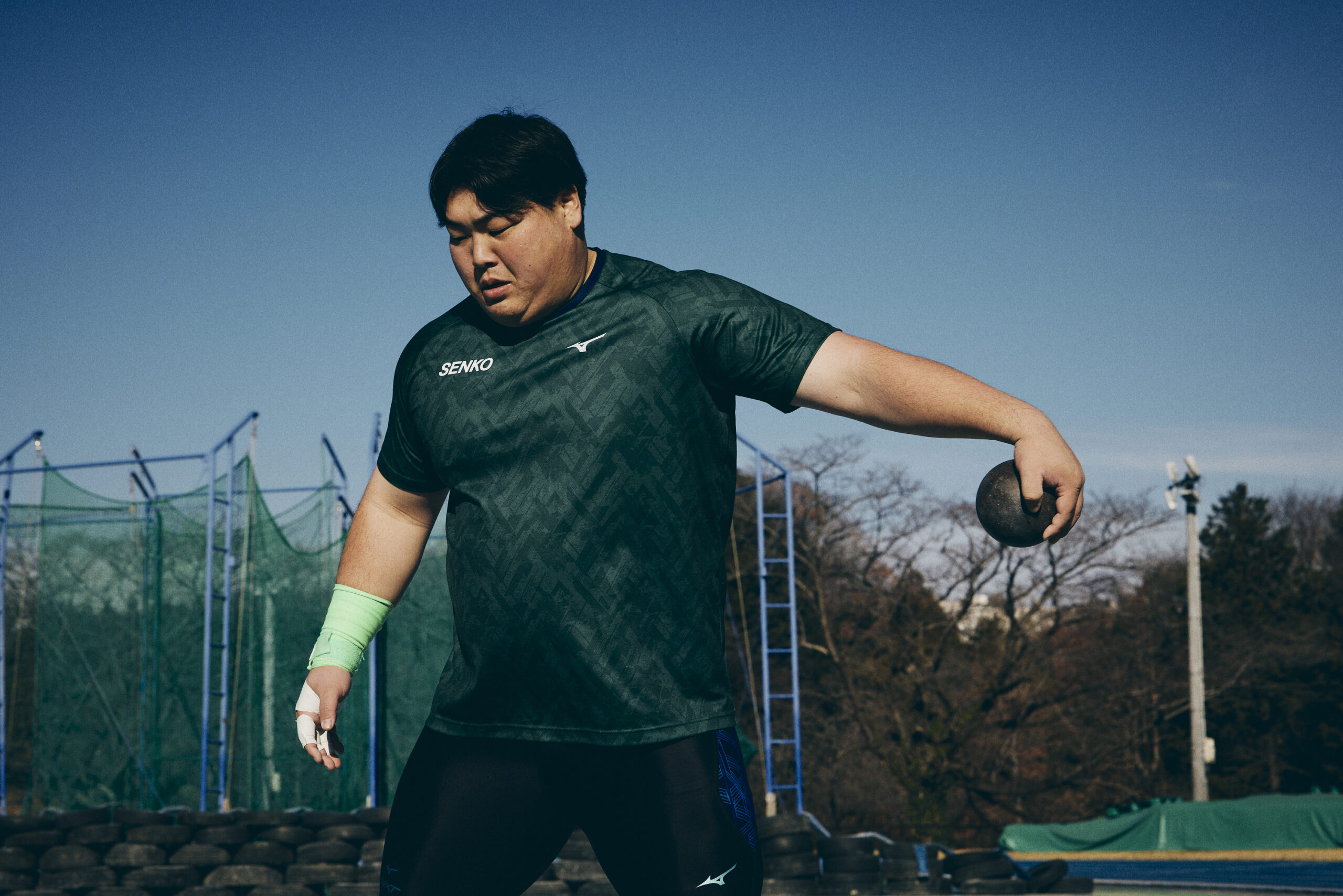
Occupational disease? Imagining how to throw at the station…
――In August last year, you broke the Japanese record by throwing 19.09m. It was the first time in Japan to record a 19m mark, but what was it like.
At that time, I was feeling really good from practice, and I was able to achieve a personal best. I was focusing on forming the shape and getting the distance, so I felt like I could “aim for 19 meters”. Moreover, it was held in my hometown Fukui. I thought that if I was going to throw it, this would be the only place to throw. It was actually the best atmosphere, and in the sixth and final throw that set the record, there was a big cheer from the locals, and the excitement was even higher than that of the Japan Championships. Even in the midst of all the excitement, I was able to keep my composure and throw in the ideal form that I had built up in practice. I was happy that I was able to embody my approach so far, including my mental performance, with the result of “breaking the Japanese record”.
On the other hand, I was excited to set a record in Japan, but what I immediately talked about with the coach was “where should I aim next?” I wasn’t satisfied with this record, and my mind shifted to aiming even higher.
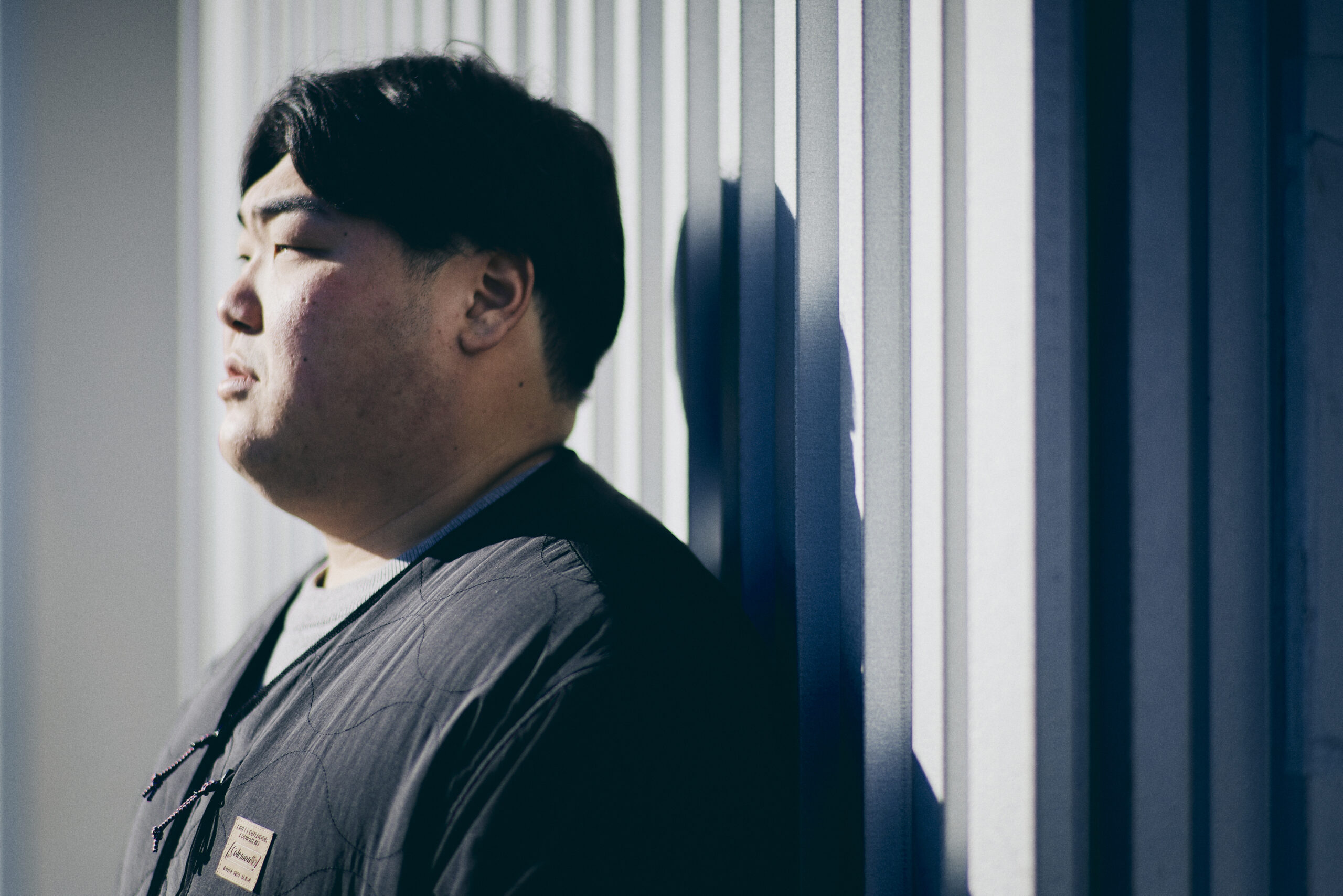
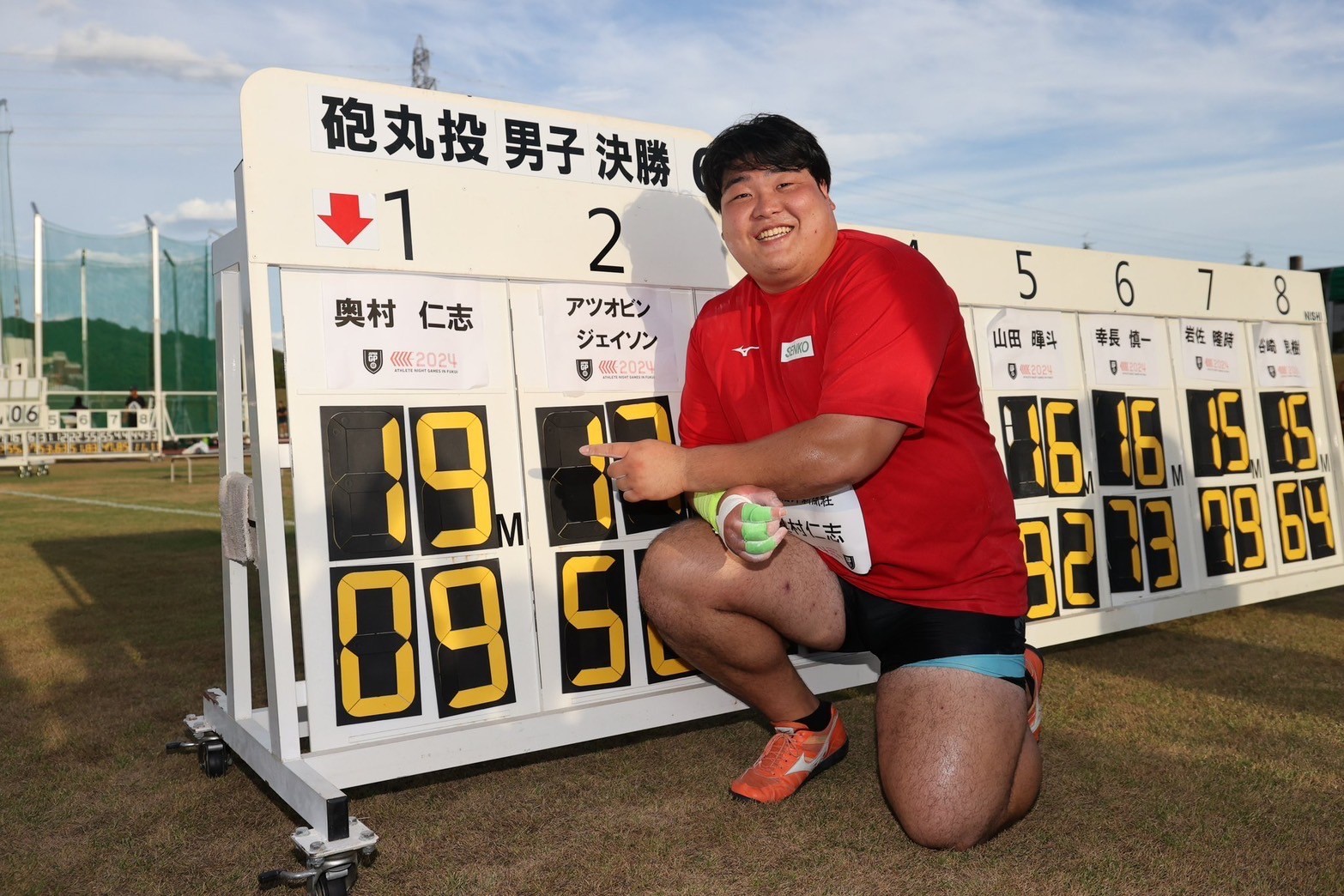
Changing history, but not satisfied…
*Courtesy of Hitoshi Okumura
――What do you think needs to be improved in order to reach that height?
It just so happened that there was only one shot at 19m, so I don’t know if I would be able to win a prize in Asia, let alone the world. I think the challenge for the future is how I can hit the 19m mark consistently. I’ve got to make a better movement than the throw I made back then and hit it further. I’m always thinking about how I can throw 19m consistently.
――The men’s world record is 23.38 meters and the Asian record is 21.80 meters. Japanese tend to have a disadvantageous physique, so how do you plan to compensate for that.
In order to close the gap between the rest of the world, I think I need to improve the “speed” of my throws, especially in addition to our technical aspects. Where there is a noticeable difference in power, of course I will strengthen the power, but it is still far from enough. In order to fill this 4m gap as much as possible, I think it is important to further develop the “Hitoshi Okumura character”. One of that is to “increase the speed”. If this approach can be successfully connected to forming my “shape”, I think I will be able to move on to the next stage.
――Is there anything you consciously work on when facing yourself on a daily basis?
I try to watch my throws every day. I also watch videos of international athletes on the train. If there is a movement that interests me, I get off at the station on the way and compare it with my throw and try to imitate it… I can’t help but want to check it out on the spot! It may be an occupational disease.
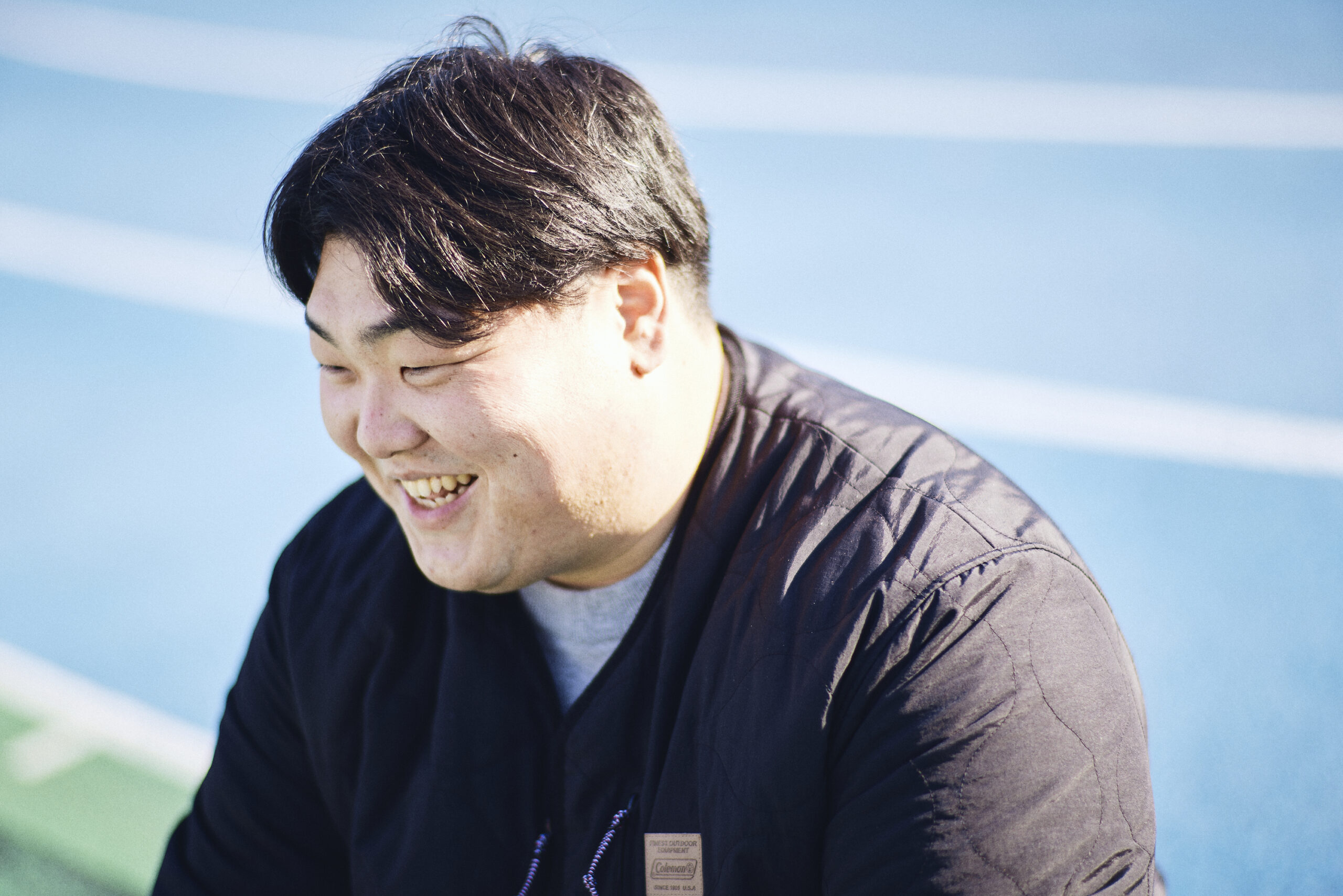
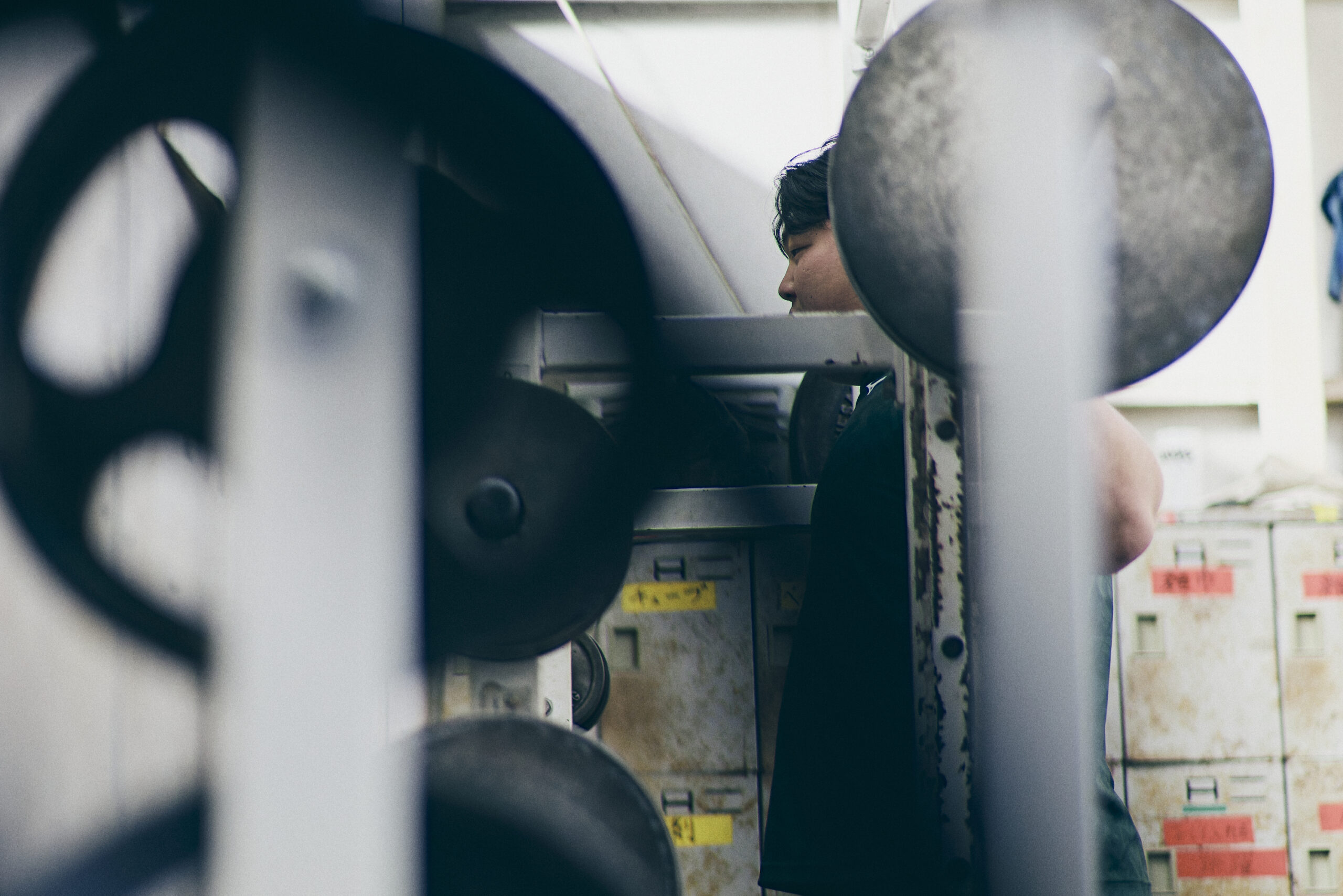
That’s what is preoccupying in his mind.
Growing awareness that “I can compete at this level”
――How do you feel about wearing the Japanese flag as a representative of Japan?
The Asian Championships was the first time I participated in a tournament as the representative of Japan. After all, since I will represent Japan, I didn’t want to do an embarrassing match. I feel a heavy responsibility wearing the Japanese flag, but if I am allowed to participate in a big competition like the World Athletics Championships in the future, I hope to have an experience that will lead to the next step.
――What kind of stage do you feel the World Athletics Championships is for you?
At the World Athletics Championships, I will be surrounded by athletes who can throw 23 meters. How can I show my true strength and be so dignified in such a situation? I don’t have many opportunities to see the world’s top athletes up close, and I believe that if I can raise my awareness to the level where I can compete with them, my ability will improve. When I competed in the Asian Championships, I felt that “I could compete at this level”, so I hope that I can feel the same way at the World Athletics Championships.
――What are your goals for the World Athletics Championships Tokyo 25?
Even if I do participate at the World Athletics Championships Tokyo 25, I have to throw more than 20 meters if I want to keep up with the other athletes. If I don’t set a record like that, I won’t be able to advance to the finals, so it’s a matter of how much I can show my abilities in such an atmosphere. I’m looking forward to discovering myself in that challenging atmosphere!
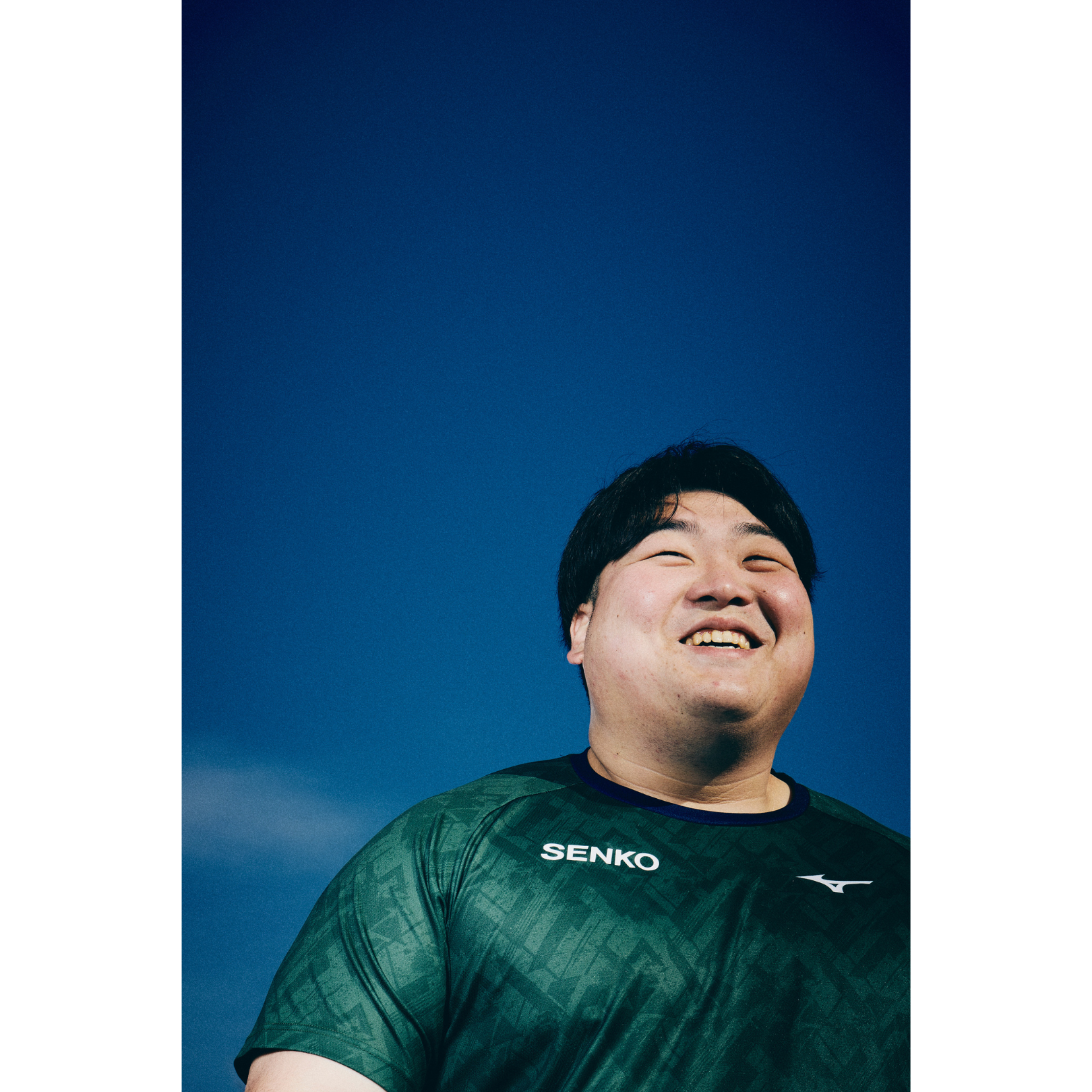
Besides track and field, baseball, football, alpine skiing
――Please tell us your personal side from here. What kind of child were you when you were little?
I was insanely having fun outside. I liked to be physically active and played a lot of different sports. Although it didn’t last long outside of track and field, but I was on a club team for baseball and football, and I also played sumo wrestling, volleyball, and alpine skiing. In baseball, I batted first or fourth as a pitcher. In football, I started out as a keeper and then as a center-back (CB). However, when I am playing CB, the slightest touch will blow my opponent away, so I was immediately fouled. I got a yellow card without really understanding it.
――You were also doing alpine skiing.
Alpine skiing was part of my physical education class at school, so I did it for about four years and I even won some prizes in the prefecture. The ski resort was close enough that I could see it from the school. It was run by an acquaintance, so everyone could use it for free.
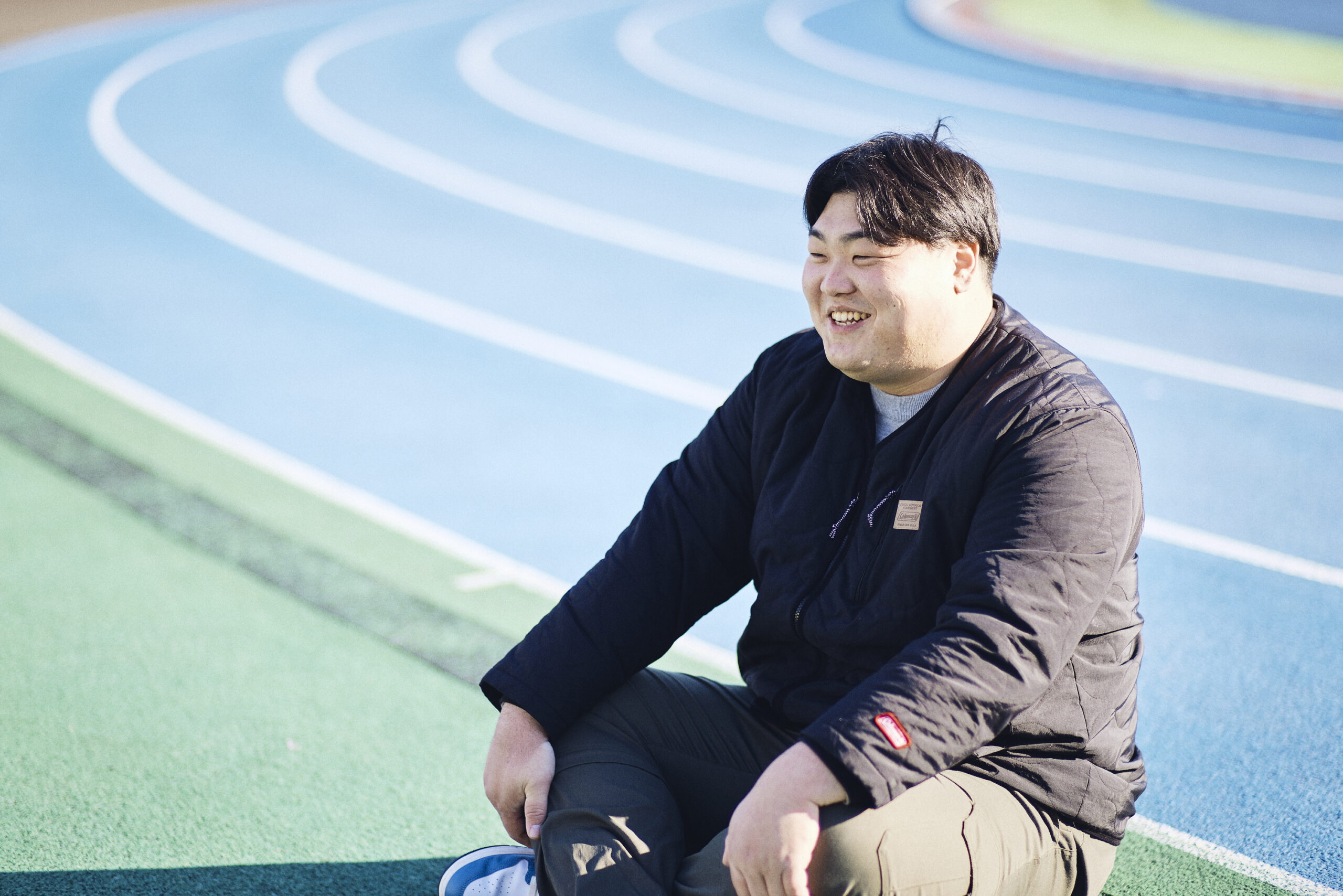
His potential could be seen since he was a boy.
――I heard that there were nine students in your junior high school, but what was your hometown like in Ono City, Fukui Prefecture?
It was really in the countryside. When I was in junior high school, it became a city, but until then it was called Izumi Village. 360-degree panoramic views of mountains as far as the eye can see. There are only mountains and rivers. It is the place where the Kuzuryu River, Fukui’s largest river, begins. You can get to the dam by bicycle. There is one now, but at that time there were no convenience stores. My friend’s house was also 7km away. It took me an hour to go by bicycle, and it took me an hour and a half on the mountain road to return.
――What was the population like?
I think there were about 500 people. I have probably met most of them. The declining birthrate and aging population are progressing too much. Sometimes, when I go home for a walk, most of the people I pass by are people that I know, so each time they talk to me and takes about 40 minutes even though it’s a road that will take you home in 10 minutes.
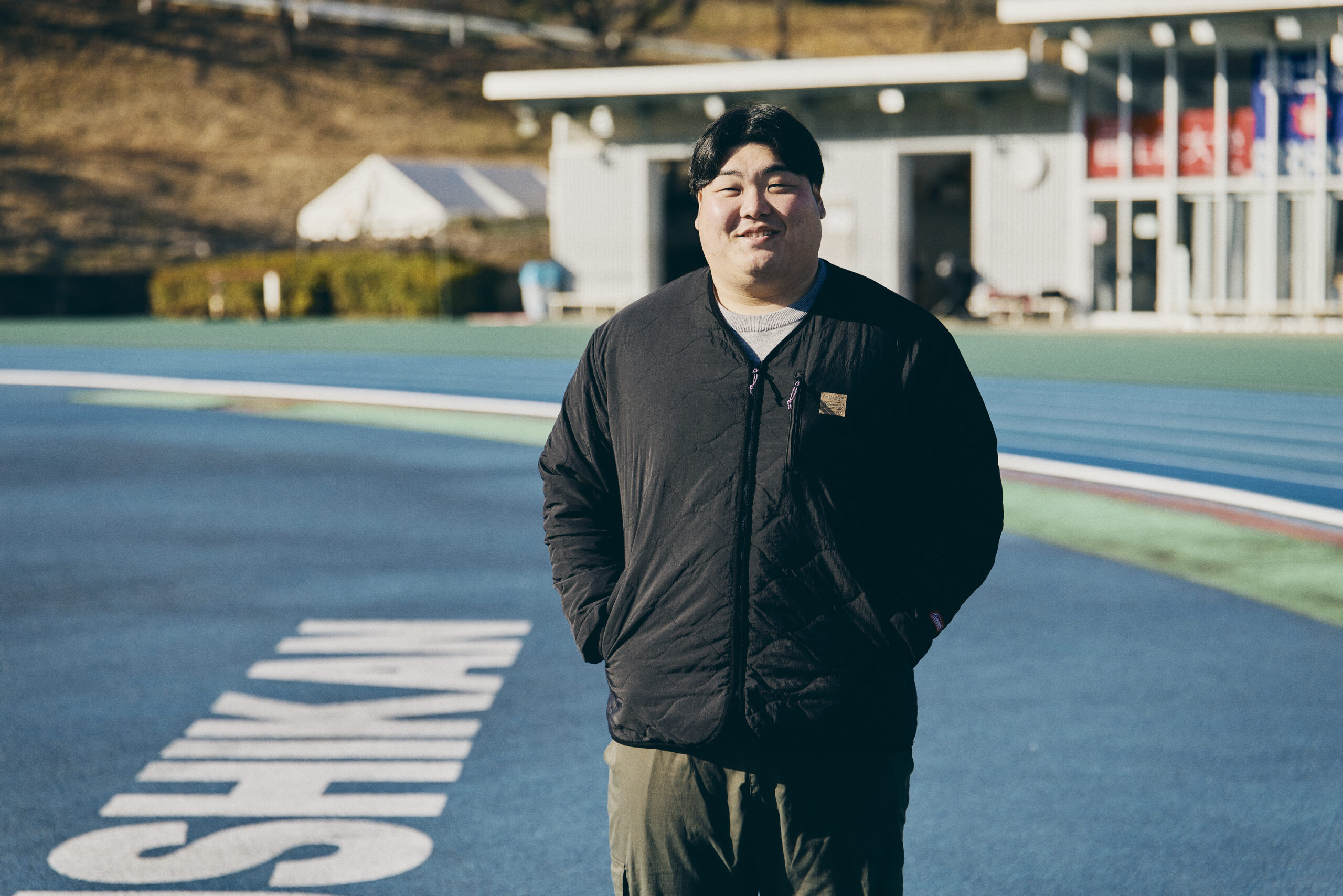
where there are “only mountains and rivers”.
Hitoshi Okumura was made with a “3-3-5” eating habit
――How do you usually spend your days off?
I’m outside more often than at home. Recently, I took my juniors to Asakusa and Shin-Okubo. Shin-Okubo was a great place. There were a lot of favorite dishes, especially the Korean oden was a nice touch.
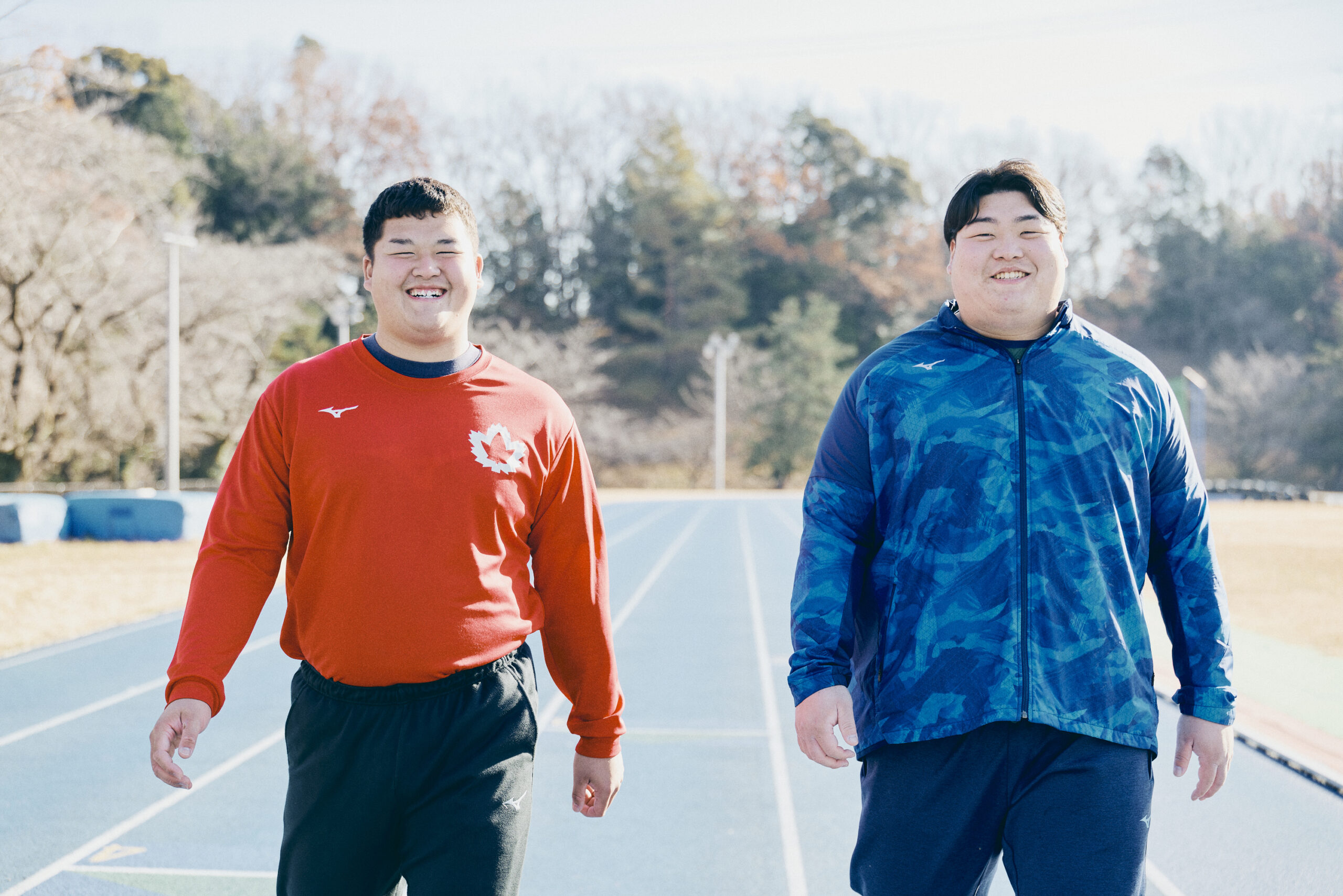
――Do you eat a lot of food?
I am pretty sure I am a person who can eat a lot. However, it has decreased recently, and I eat about 2 to 3 cups of rice per meal.
――Can you say that it has decreased?
I ate the most when I was in my 1st to 2nd year of university. At that time, it was about 4~5 cups of rice per meal.
――Is that three meals?
No, no, it’s only at night. It’s about 3 cups in the morning, 3 cups at noon, and 5 cups at night.
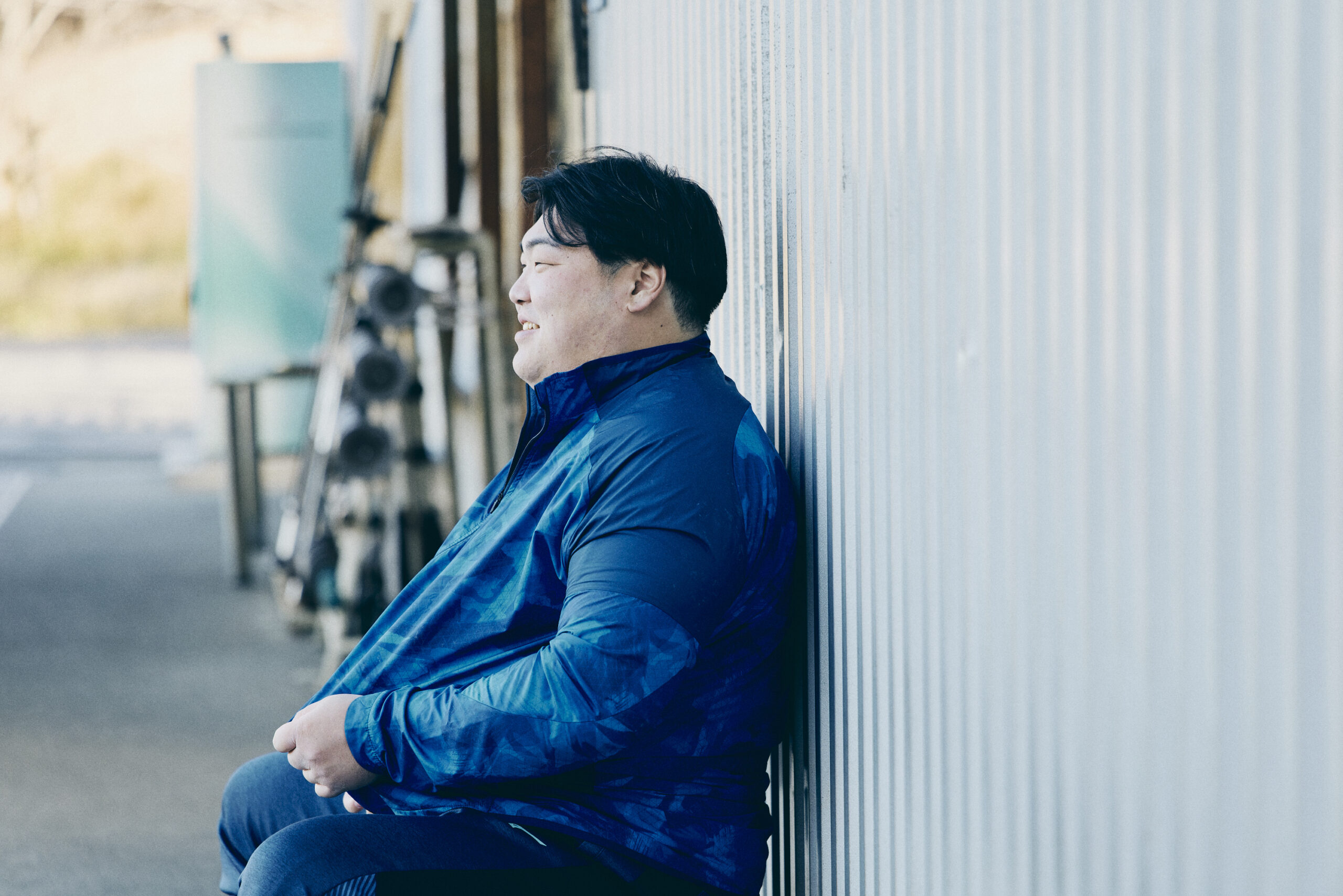
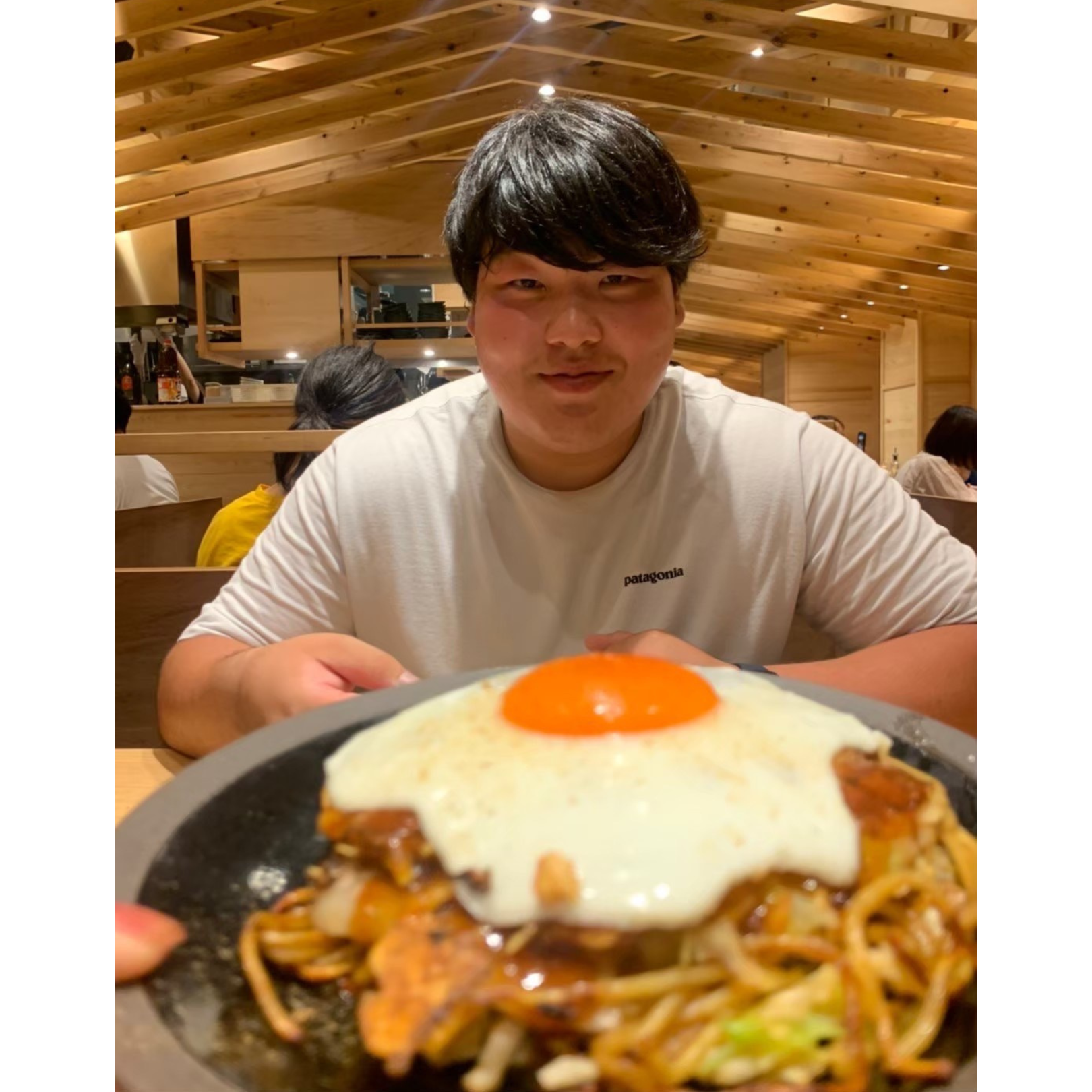
He is a big eater!
――Do you cook for yourself on a daily basis?
Sometimes. It’s really like grilling chicken. Other than that, I eat at a nearby restaurant. There is an all-you-can-eat restaurant nearby, so I’ve been there four times in the past month. Also, I like sukiyaki, so please let me know if you have any place to recommend!
――Please tell us if there is anything you have been into lately.
It will be eating while walking. I like to go around the city, but I also go to various places for tournaments, so I really want to taste delicious foods from all over the country. But basically, I return to Tokyo as soon as I’m done, so I can’t do much sightseeing… But sometimes when I have time, I enjoy going out to eat.
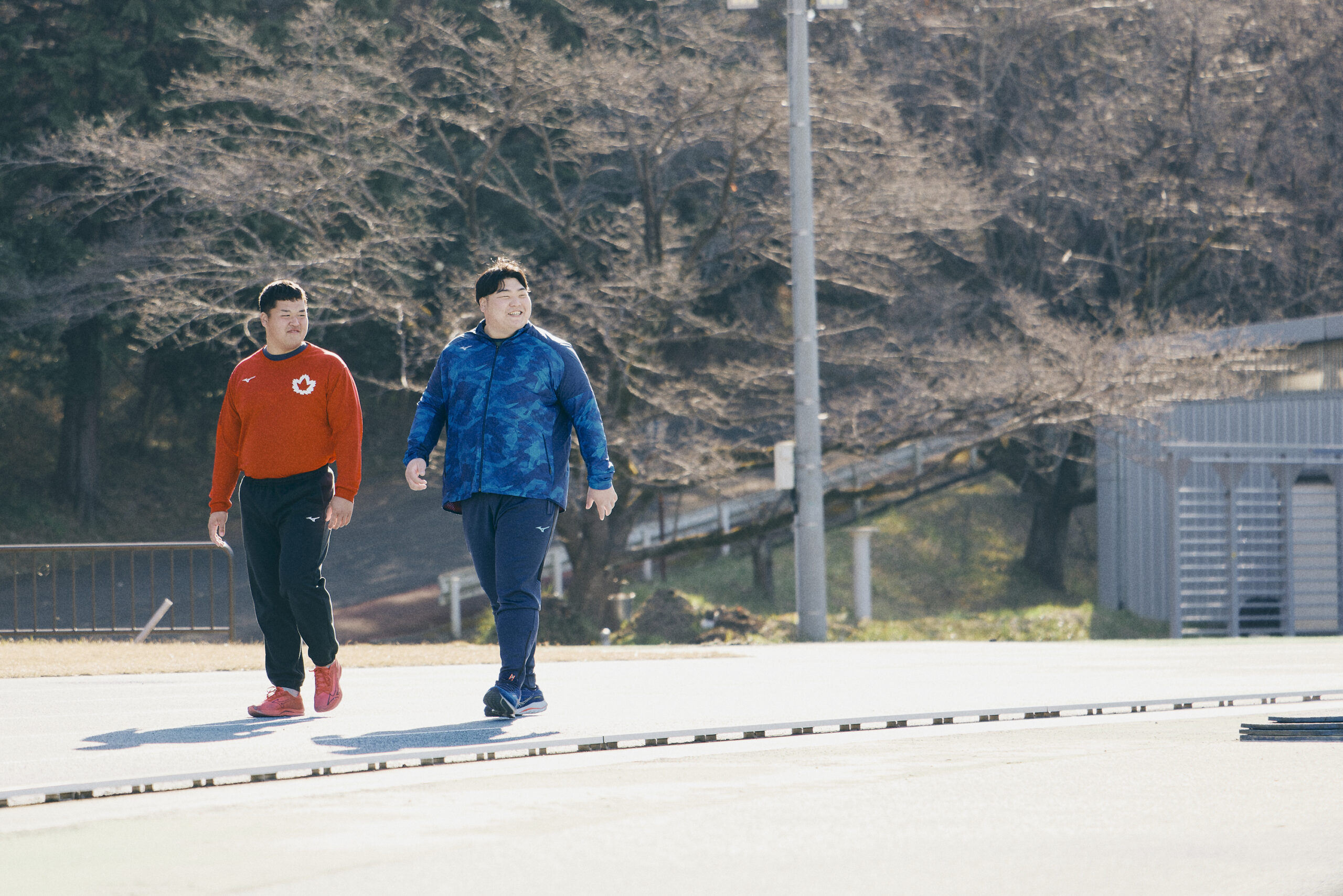
Seniors who I don’t have to worry about and can have a good time
――Are there any athletes you would recommend other than yourself?
It’s the javelin thrower Gen Naganuma. He is a senior at university, and we get along well. We go out for a meal together, and he’s a strong athlete. He’s not that tall, but he runs very fast and throws dynamically. He is my favorite player to watch in the javelin throw. We get along well together. We joke around with each other, and although he is my senior, I don’t have to worry about and I can have a good time. I like people who are energetic and can share their grooves. I am also a person who likes to joke around quite a bit.
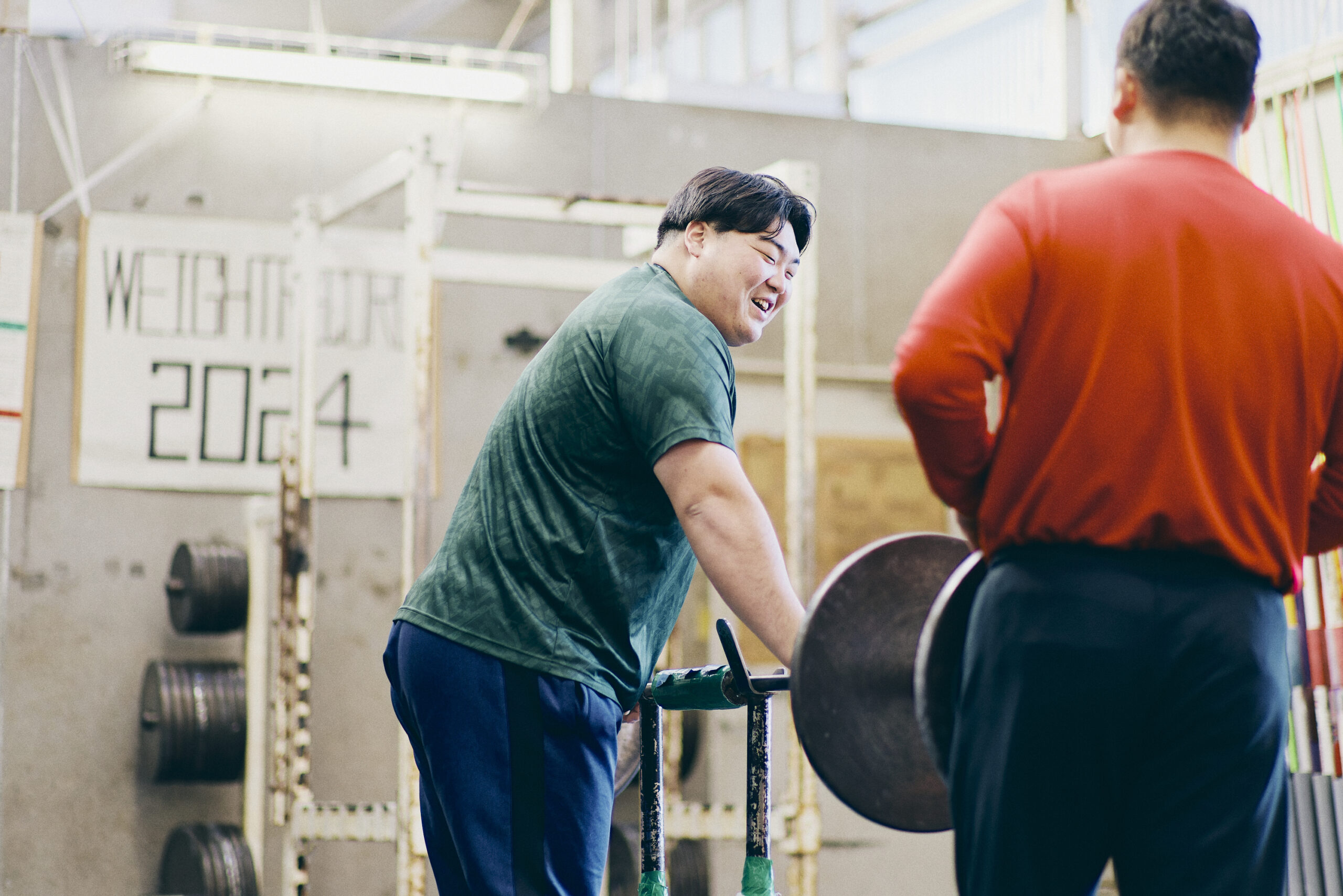
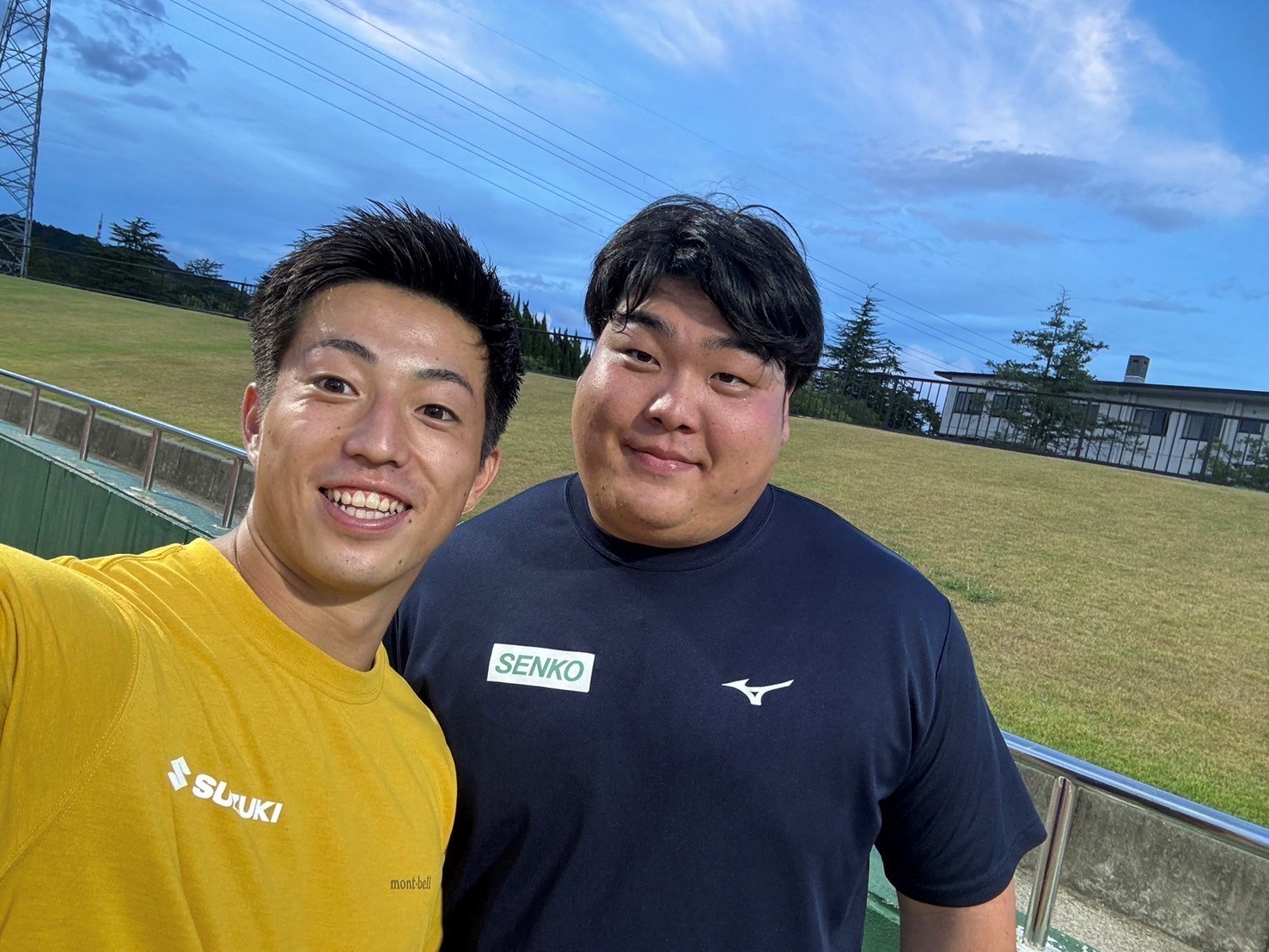
“He is my favorite athlete to watch” he says who he respects as an athlete.
*Courtesy of Hitoshi Okumura
――Surely, I felt a gap between you and during the competition.
The difference between when I’m concentrating on the competition and when I’m not is quite drastic. When I’m on my day off, I try to keep myself laughing, but when I’m concentrating on the competition, I often don’t say anything. I strive to live a well-balanced life. Gen Naganuma understands that kind of thing, so he is a wonderful person who is easy to be with.
――Finally, please give us a message for our readers who are looking forward to the World Athletics Championships Tokyo 25?
The university is also located in Tokyo, and I think there will be a lot of people who will support me and a lot of friends who will come to watch, so I’m really looking forward to it. The World Athletics Championships held overseas are far away, but this time you can easily go and watch them. I hope a lot of people will come to see it. If I can participate, I would like to give it my all, so I would be very grateful if you could support me. Please come and visit the National Stadium! I look forward to your support!!
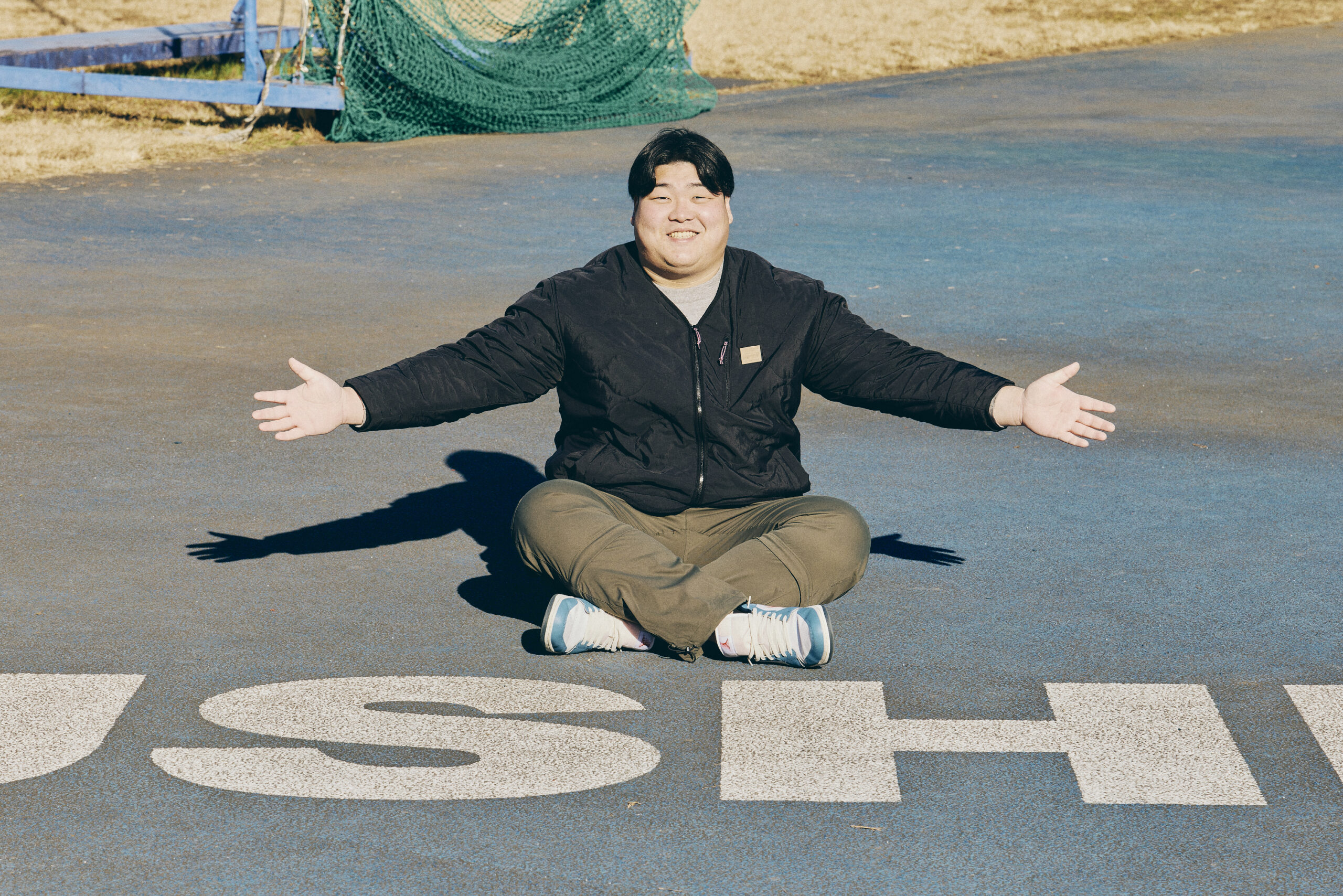

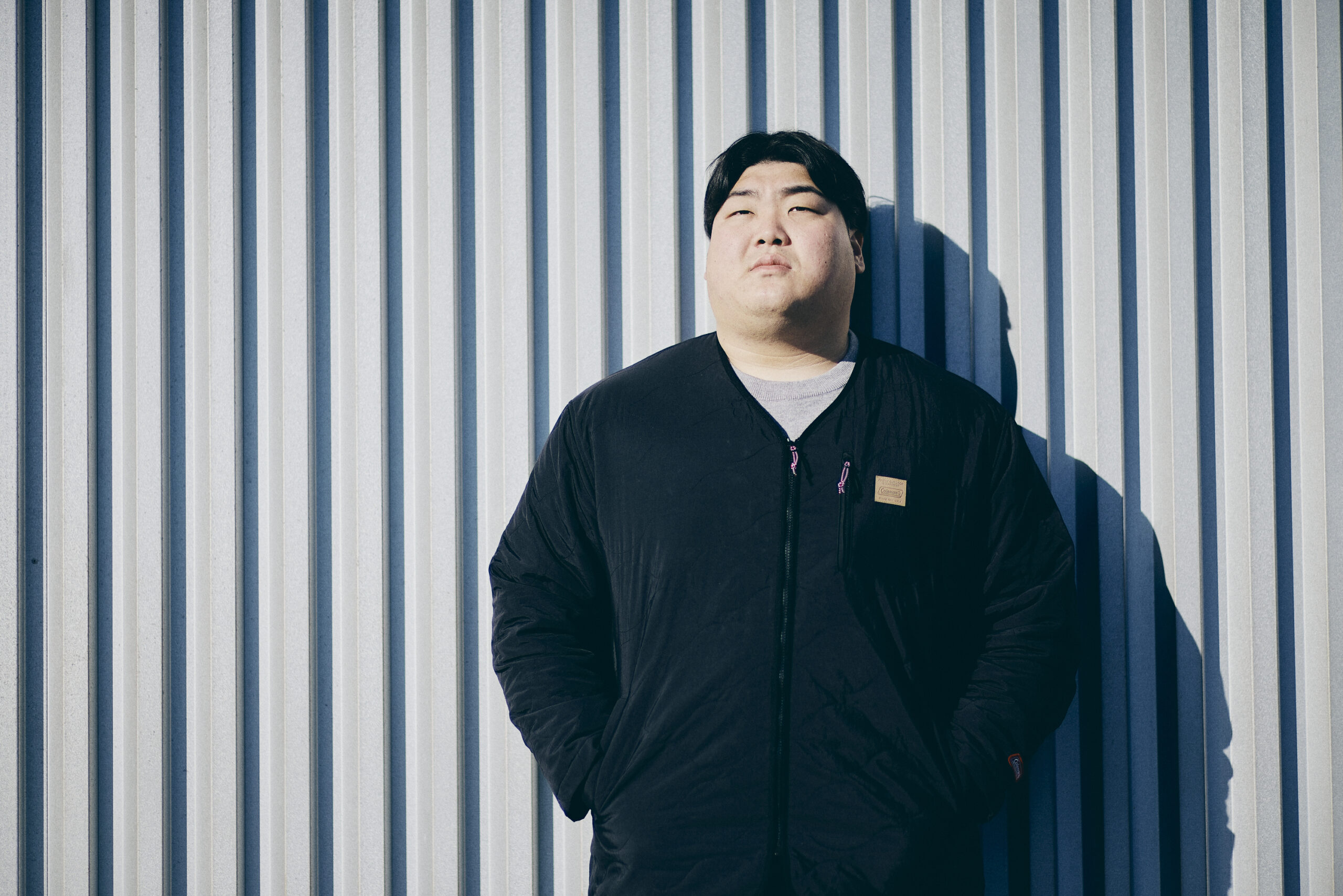
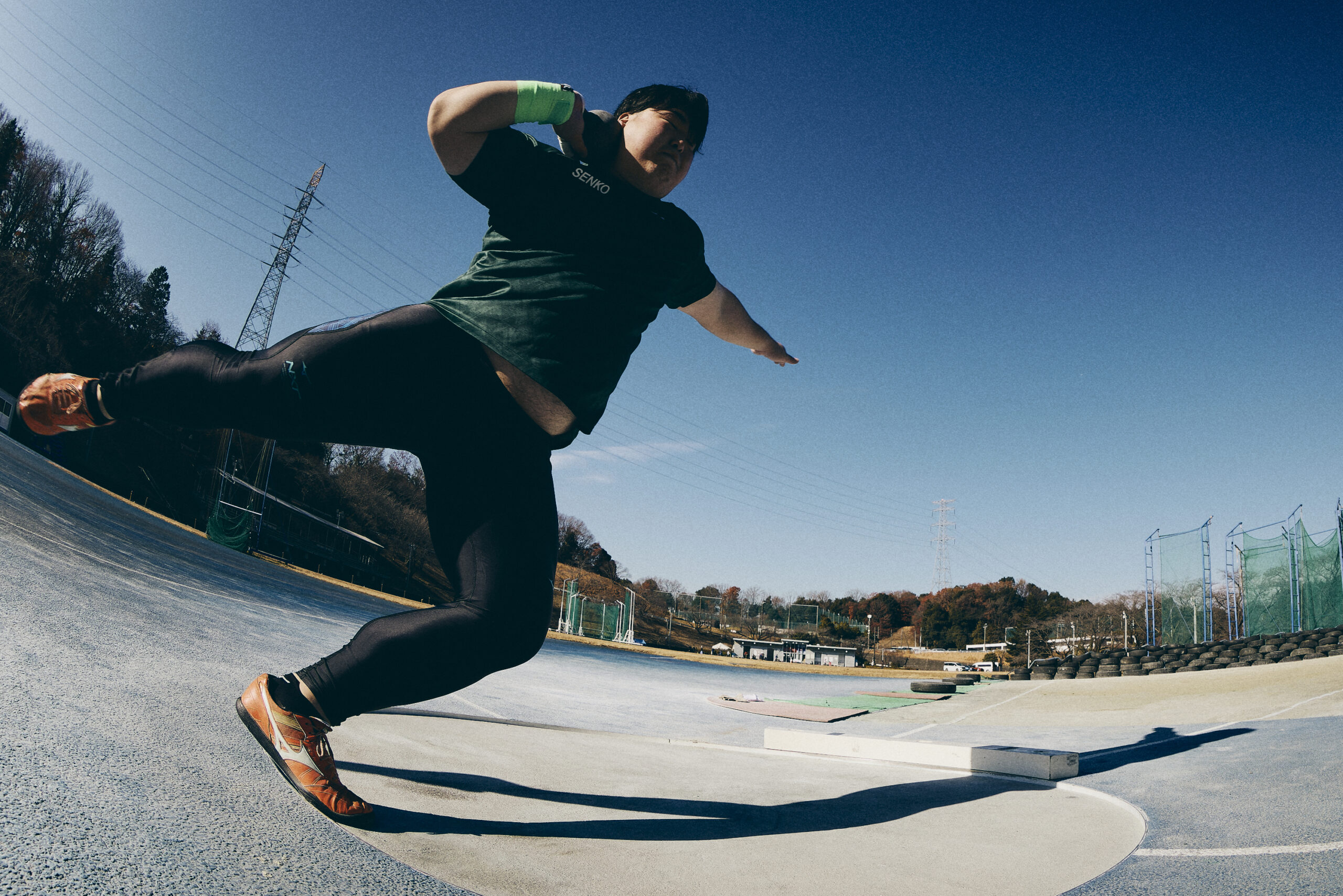
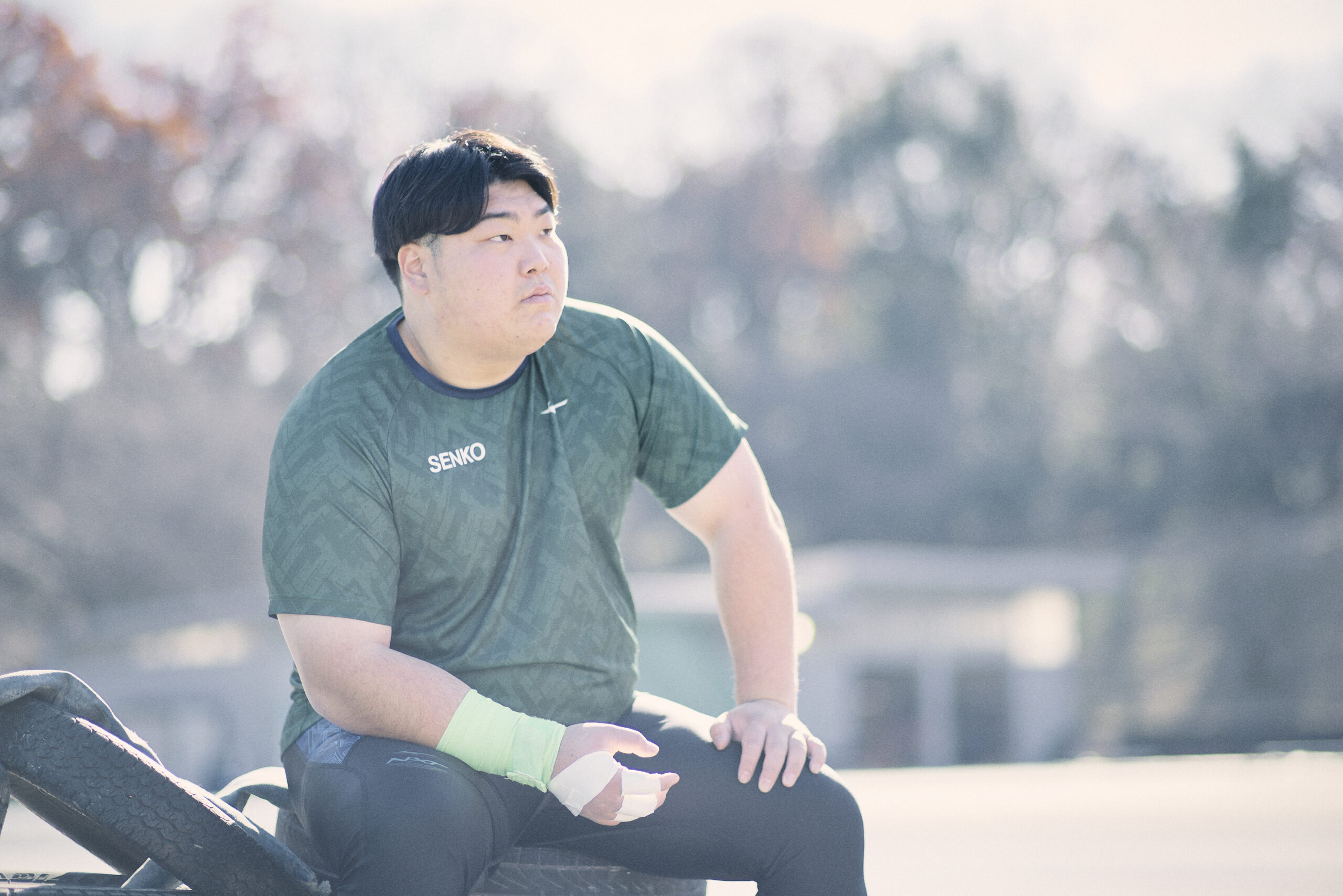
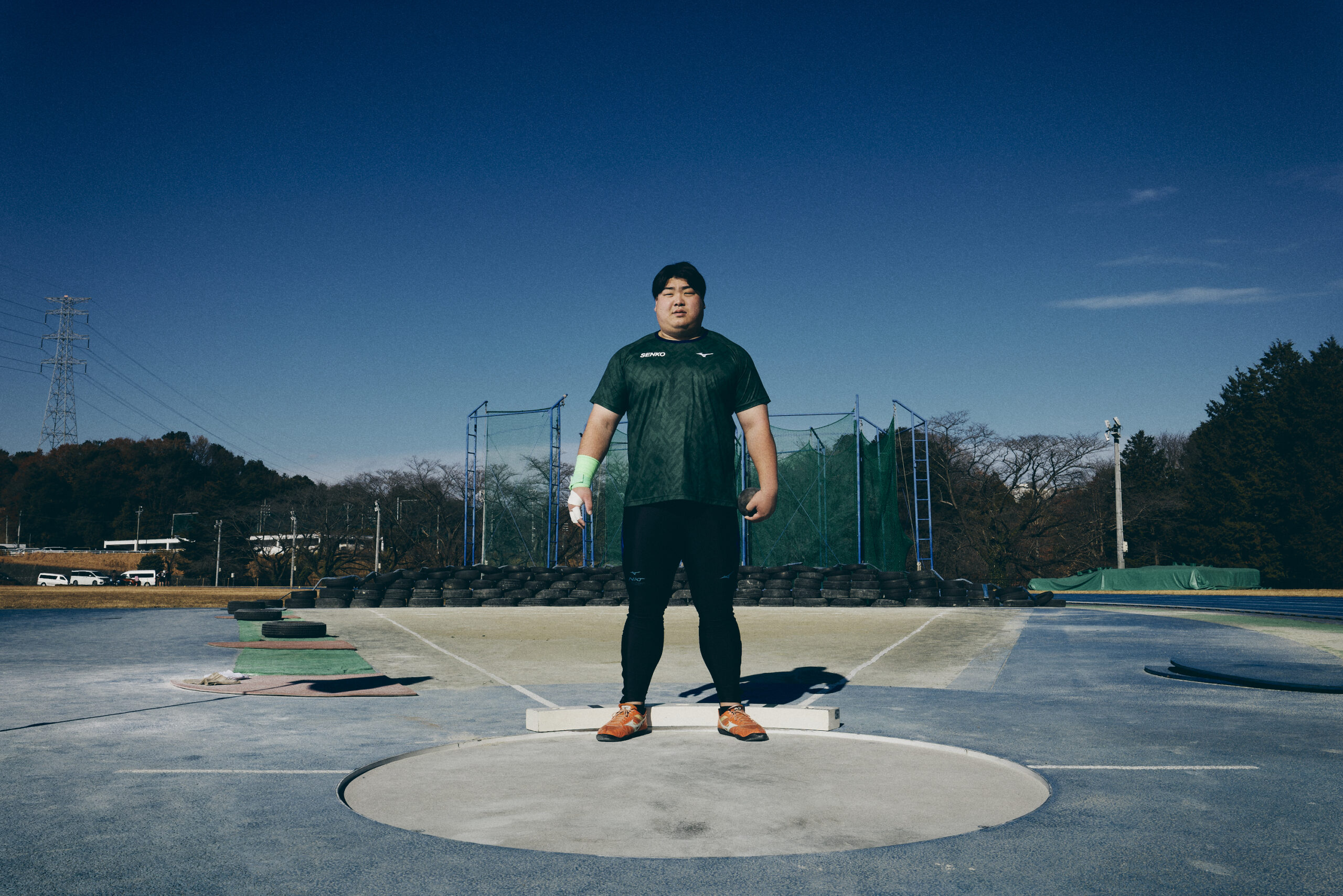
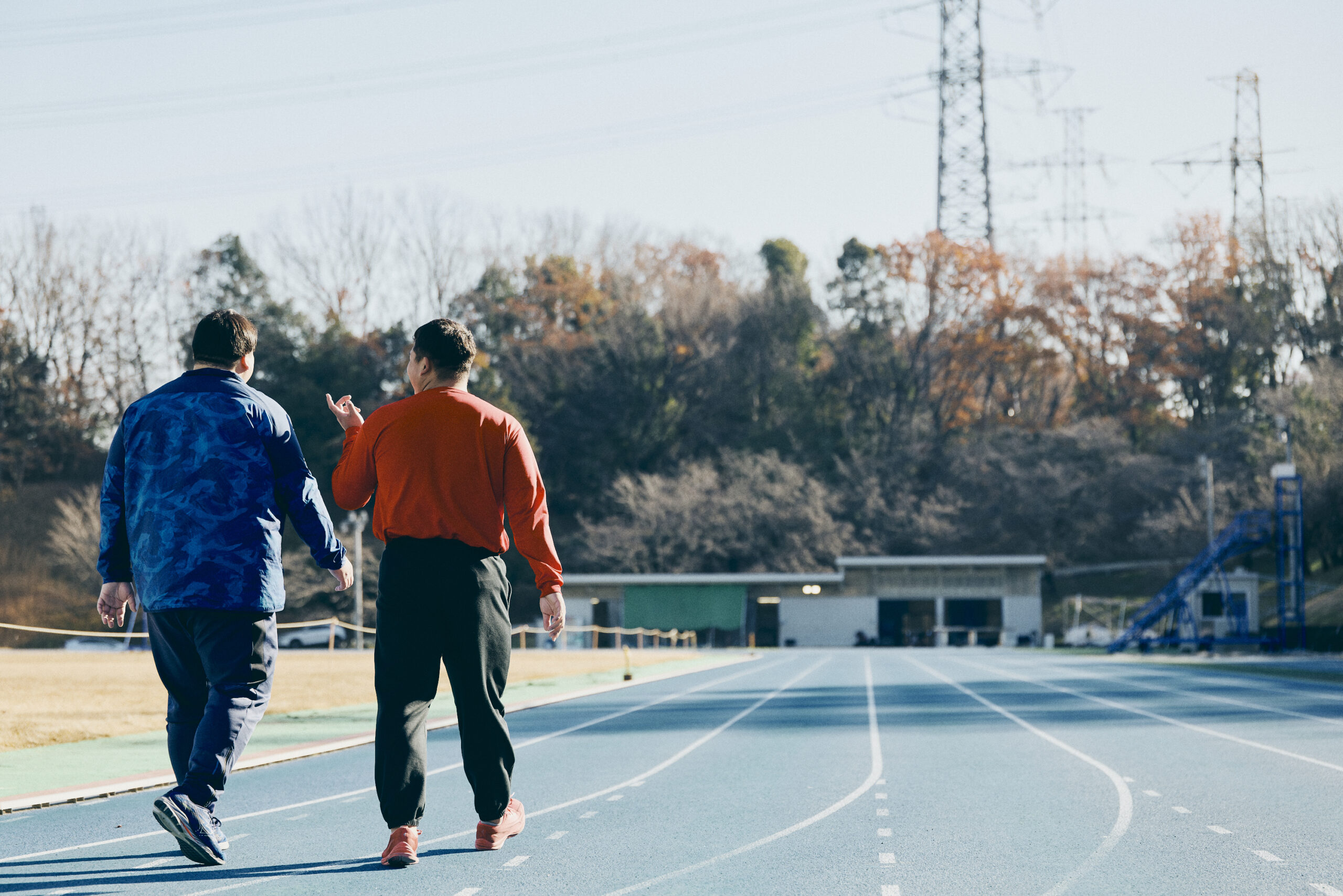
Instagram:dhitoshi_0324
text by Moritaka Ohashi
photographs by Uta Mukuo

